PRINCIPLES OF INHERITANCE AND VARIATIONS for Class 12 BIOLOGY
INTRODUCTION
- The term genetics (Gk. Genesis - descent} was coined by Bateson (1906). Genetics is the study of principles and mechanisms of heredity and variations. The resemblance amongst offspring is never 100% (except in monozygotic twins) due to reshuffling of chromosomes and their genes. Heredity is the study of transmission of genetic characters and variations from one generation to the next. Heredity involves the transfer of chromosomes from parents to offspring or one individual to another. Therefore, chromosomes are the base of heredity. The physical basis of heredity are genes while the chemical basis of heredity is DNA. Variations are differences found in morphological, physiological and cytological behaviouristic traits of individuals belonging to the same Species, race and family. They appear in offspring or siblings due to :
- Reshuffling of genes on chromosomes by chance separation of chromosomes.
- Crossing over.
- Chance combination of chromosomes during meiosis and fertilization.
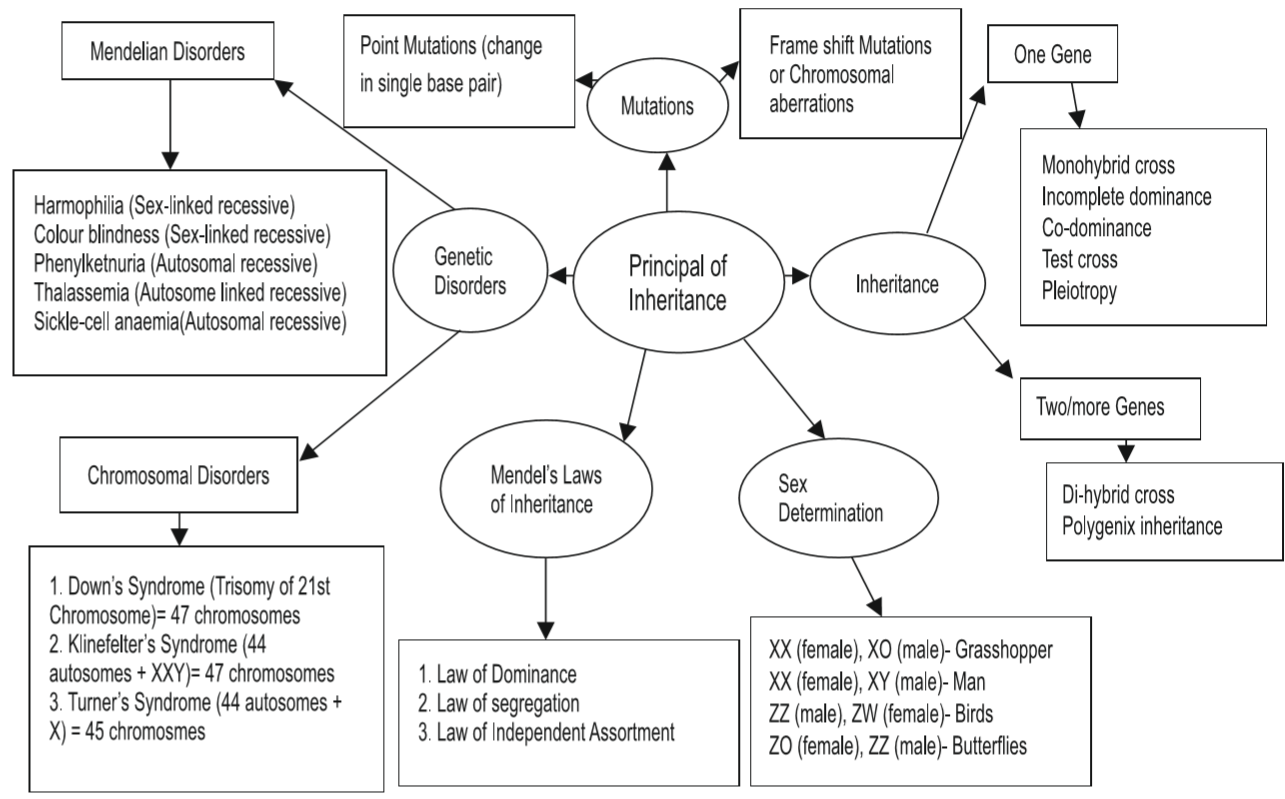
INTRODUCTION
- The term genetics (Gk. Genesis - descent} was coined by Bateson (1906). Genetics is the study of principles and mechanisms of heredity and variations. The resemblance amongst offspring is never 100% (except in monozygotic twins) due to reshuffling of chromosomes and their genes. Heredity is the study of transmission of genetic characters and variations from one generation to the next. Heredity involves the transfer of chromosomes from parents to offspring or one individual to another. Therefore, chromosomes are the base of heredity. The physical basis of heredity are genes while the chemical basis of heredity is DNA. Variations are differences found in morphological, physiological and cytological behaviouristic traits of individuals belonging to the same Species, race and family. They appear in offspring or siblings due to :
- Reshuffling of genes on chromosomes by chance separation of chromosomes.
- Crossing over.
- Chance combination of chromosomes during meiosis and fertilization.

INTRODUCTION
- The term genetics (Gk. Genesis - descent} was coined by Bateson (1906). Genetics is the study of principles and mechanisms of heredity and variations. The resemblance amongst offspring is never 100% (except in monozygotic twins) due to reshuffling of chromosomes and their genes. Heredity is the study of transmission of genetic characters and variations from one generation to the next. Heredity involves the transfer of chromosomes from parents to offspring or one individual to another. Therefore, chromosomes are the base of heredity. The physical basis of heredity are genes while the chemical basis of heredity is DNA. Variations are differences found in morphological, physiological and cytological behaviouristic traits of individuals belonging to the same Species, race and family. They appear in offspring or siblings due to :
- Reshuffling of genes on chromosomes by chance separation of chromosomes.
- Crossing over.
- Chance combination of chromosomes during meiosis and fertilization.

CHAPTER WEIGHTAGE
- Yeah chapter genetics and evolution ki unit ka first chapter hai. The whole unit is of 18 marks jo ki kisi bhi unit ke comparison me sabse zyada hai. This unit is a bit difficult and requires more practice than the most but ek baar samajh aa gaya toh kafi scoring unit hai.
CHAPTER WEIGHTAGE
- Yeah chapter genetics and evolution ki unit ka first chapter hai. The whole unit is of 18 marks jo ki kisi bhi unit ke comparison me sabse zyada hai. This unit is a bit difficult and requires more practice than the most but ek baar samajh aa gaya toh kafi scoring unit hai.Toh a minimum of 4-5 questions expected hi hain
CHAPTER WEIGHTAGE
- Yeah chapter genetics and evolution ki unit ka first chapter hai. The whole unit is of 18 marks jo ki kisi bhi unit ke comparison me sabse zyada hai. This unit is a bit difficult and requires more practice than the most but ek baar samajh aa gaya toh kafi scoring unit hai.Toh a minimum of 4-5 questions expected hi hain
BASIC TERMS USED THROUGHOUT THE CHAPTER
- GENE : by definition, “gene is the functional segment of DNA”. Aapka DNA aapki puri genetic information ko code karta hai but pura ka pura DNA nahi. Usme kuch part coding hota hai and kuch non coding (junk). Toh jo coding part hota hai usme bahut sare genes hote hain. Ek gene kisi ek particular character ke liye code karta hai and yeah bhi possible hai ki ek character ko ek se zyada genes code karein. Ab yha par coding and non coding ka kya matlab hai uski puri detail aapko next chapter me samajh aaygi but as of now roughly iss tarike se samjho ki jaisey eye color hai toh uske liye aapke DNA me ek particular coding hoti hai (ya fir yeah kehdo ki DNA ki ek particular segment hoti hai jo colour decide karegi ki colour blue hoga, green hoga ya black ya brown hoga - it's an rough/raw idea just to familiarize you guys with the concept of gene.) and that part is known as GENE.
- ALLELE : We humans are diploid. Yani ki chromosomes ke 2 sets hote hain, ek se papa se milta hai yani ki paternal and ek set Mom se milta hai yani ki maternal set of chromosomes. Toh har chromosome pe genes hote hain. Toh chromosome par gene ki location LOCUS kehlati hai. Ek example dekho ki ek couple hai jisme male ki blue eyes and female ki green eyes hain. Ab mainly eye colour ke liye jo genes hote hain wo chromosome number 15 par hote hain (NO need to memorise this, bas samjhane ke liye hai). Toh zygote ya inke baby me chromosome 15 ki 2 copies hongi, ek papa se and ek mom se. Ab chromosome 15 par same location me paternal par blue eyes ke liye responsible genes honge and maternal chromosome 15 par ussi location par green eyes ke liye genes honge. But ek basic level par dekhe toh yeah genes hai toh eye ke colour ke liye hi but yeah different forms hai unhi genes ki. Toh hum inko alternate forms of genes kehte hain and yhi definition hoti hai ALLELES ki. Toh allele kya hua : alternate forms of a gene.
- Issi case ko aage badhte hue, lets say uss couple ka jo baby hai uski eyes ka colour green hai. Lekin uss baby me gene toh blue eyes ke liye bhi tha but baby me blue eyes express nhi hui. Toh jis allele ka progeny(Children/Bache) me expression dikhta hai wo DOMINANT ALLELE kehlata hai. And jo khud ko express na kar paya (yani ki jiska asar hume baby me nahi dikha) wo RECESSIVE ALLELEhua. Iss cheez ko aisey samjho ki zygote me eyes colour ke dono alleles me contest hota hai and jo jeet gya uska expression baby me dikhega. Toh jeetne wala dominant and haarne wala recessive allele hua.
- Ab lets say ki uper wale example me jo couple hai usme male ke dono parents (yani ki baby ke grandparents : Dada and Dadi) blue eyes waley hain toh male me jo eye colour ke genes hain wo dono genes (one from each parent) blue colour ke hain. Yani ki dono alleles same hi hai toh aisi condition hoti hai homozygous condition and iss character ko kahenge HOMOZYGOUS CHARACTER. Homo ka matlab hai 'same' and zygous ka matlab hai 'jo genes present hai'. Similarly hum assume kar letey hain ki jo female hai upar wale couple me usme bhi jo eye colour ke genes hain sabhi green eyes ke liye hain toh mother me bhi sabhi genes same product bnayenge (
product ka yhaan par matlab hai "eyes ke green colour" se. ) toh we will say ki female is HOMOZYGOUS for green eye colour gene. But in dono ka jo baby hai usme blue and green eyes dono ke genes present hai. Toh it's like ki unke baby me mixed genes hain (blue and green eye colour ke liye), toh baby ki condition ko hum HETEROZYGOUS kehte hain. Heteros ka matlab hai "different" and zygous is for "genetic composition". Ek aisi condition jisme ek character (ex : eye colour) ke liye different genes (genes for blue and green eyes) present ho. - Next hume discuss karna hai : Wild and Mutant allele. Wild allele wo hota hai jo original population me present hai and majority me dominant character hota hai. For example brown eye colour ek wild type allele hai. Kafi hazaro saal pehly issi gene me kuch mutation (mutation boley toh "change") hui and we got green and blue colour eyes. Toh blue eyes ka gene ek mutant allele hai jo bahut kam humans me present hai. Toh jis original/parent gene se mutant gene banta hai usko hum wild type kehte hain.
- Genotype represents the genetic composition of an individual for a particular trait and phenotype means the physical appearence. For eg: a homozygous tall plant has a tall stem (this is phenotype) and we represent it by TT (TT here represents the genotype).
- Back cross is a cross between any of the progeny to another individual with homozygous recessive genotype to determine the exact genotype of the progeny. Test cross is a cross between any of the progeny members with any of the parents.
- This ends our discussion on terms that we will be using throughout our genetics unit. Keval iss chapter me nhi but agle dono chapters me bhi yeah terms important hai.
IMPORTANT TERMS
- GENE
- Mendel named them ‘Factor’.
- It is an inherited factor that determines the biological character of an organism.
- Functional unit of hereditary material.
GENOME - Total set of genes in a haploid set of chromosomes and inherited as a unit from parents to offspring.
Or - A genome is an organism's complete set of DNA, including all of its genes.
ALLELOMORPHS OR ALLELES
- Alternative forms of the same genes, having the same position on homologous chromosomes.
- Example: Tall TT and dwarf tt are alternate forms of the same gene.
GENE LOCUS - Specific place on chromosome where gene is located.
DOMINANT FACTOR OR ALLELE - Allele which expresses itself whether present in the homozygous or heterozygous state.
- By convention it is represented by capital or upper case letter. E.g T.
RECESSIVE FACTOR OR ALLELE - Allele which expresses itself only in homozygous condition.
- By convention it is represented by a small or lower case letter. E.g. t.
- The allele which was originally present in the population, is dominant and usually widespread.
- The recessive allele is less common and is believed to be formed by mutation of the wild allele. It is, therefore, also called a mutant allele.
HOMOZYGOUS - It is an individual which contains identical alleles of a gene on its homologous chromosome.
- It’s of two types:
1). Homozygous Dominant: TT
2). Homozygous Recessive: tt
HETEROZYGOUS - It is an individual which contains two different alleles on its homologous chromosomes.
- Example: Tt
GENOTYPE - Genetic constitution of an organism is called Genotype.
- Example: TT and Tt are two different genetic constitutions but the product of both genotypes is the same that is Tall.
PHENOTYPE - External feature or observable characteristic of an organism.
- Example: Colour, behaviour etc.
PUNNETT SQUARE - It is a checker-board used to show the result of a cross between two organisms and genotypes as well as phenotypes of the progeny.
- It is also called a gametic checker board because it takes into consideration all the possible gametes and their random fusion.
- Each of the possible gametes is placed in an individual column or a row, with a vertical column representing the female and horizontal row the male parent. Two simplified versions are genotypic checker board and phenotypic checkerboard where the possible genotype probabilities are combined through multiplication. Genotypic and phenotypic probabilities can also be combined at random through the branching system.
WILD AND MUTANT ALLELES
IMPORTANT TERMS
- GENE
- Mendel named them ‘Factor’.
- It is an inherited factor that determines the biological character of an organism.
- Functional unit of hereditary material.
GENOME - Total set of genes in a haploid set of chromosomes and inherited as a unit from parents to offspring.
Or - A genome is an organism's complete set of DNA, including all of its genes.
ALLELOMORPHS OR ALLELES
- Alternative forms of the same genes, having the same position on homologous chromosomes.
- Example: Tall TT and dwarf tt are alternate forms of the same gene.
GENE LOCUS - Specific place on chromosome where gene is located.
DOMINANT FACTOR OR ALLELE - Allele which expresses itself whether present in the homozygous or heterozygous state.
- By convention it is represented by capital or upper case letter. E.g T.
RECESSIVE FACTOR OR ALLELE - Allele which expresses itself only in homozygous condition.
- By convention it is represented by a small or lower case letter. E.g. t.
- The allele which was originally present in the population, is dominant and usually widespread.
- The recessive allele is less common and is believed to be formed by mutation of the wild allele. It is, therefore, also called a mutant allele.
HOMOZYGOUS - It is an individual which contains identical alleles of a gene on its homologous chromosome.
- It’s of two types:
1). Homozygous Dominant: TT
2). Homozygous Recessive: tt
HETEROZYGOUS - It is an individual which contains two different alleles on its homologous chromosomes.
- Example: Tt
GENOTYPE - Genetic constitution of an organism is called Genotype.
- Example: TT and Tt are two different genetic constitutions but the product of both genotypes is the same that is Tall.
PHENOTYPE - External feature or observable characteristic of an organism.
- Example: Colour, behaviour etc.
PUNNETT SQUARE - It is a checker-board used to show the result of a cross between two organisms and genotypes as well as phenotypes of the progeny.
- It is also called a gametic checker board because it takes into consideration all the possible gametes and their random fusion.
- Each of the possible gametes is placed in an individual column or a row, with a vertical column representing the female and horizontal row the male parent. Two simplified versions are genotypic checker board and phenotypic checkerboard where the possible genotype probabilities are combined through multiplication. Genotypic and phenotypic probabilities can also be combined at random through the branching system.
WILD AND MUTANT ALLELES
IMPORTANT TERMS
- GENE
- Mendel named them ‘Factor’.
- It is an inherited factor that determines the biological character of an organism.
- Functional unit of hereditary material.
GENOME - Total set of genes in a haploid set of chromosomes and inherited as a unit from parents to offspring.
Or - A genome is an organism's complete set of DNA, including all of its genes.
ALLELOMORPHS OR ALLELES
- Alternative forms of the same genes, having the same position on homologous chromosomes.
- Example: Tall TT and dwarf tt are alternate forms of the same gene.
GENE LOCUS - Specific place on chromosome where gene is located.
DOMINANT FACTOR OR ALLELE - Allele which expresses itself whether present in the homozygous or heterozygous state.
- By convention it is represented by capital or upper case letter. E.g T.
RECESSIVE FACTOR OR ALLELE - Allele which expresses itself only in homozygous condition.
- By convention it is represented by a small or lower case letter. E.g. t.
- The allele which was originally present in the population, is dominant and usually widespread.
- The recessive allele is less common and is believed to be formed by mutation of the wild allele. It is, therefore, also called a mutant allele.
HOMOZYGOUS - It is an individual which contains identical alleles of a gene on its homologous chromosome.
- It’s of two types:
1). Homozygous Dominant: TT
2). Homozygous Recessive: tt
HETEROZYGOUS - It is an individual which contains two different alleles on its homologous chromosomes.
- Example: Tt
GENOTYPE - Genetic constitution of an organism is called Genotype.
- Example: TT and Tt are two different genetic constitutions but the product of both genotypes is the same that is Tall.
PHENOTYPE - External feature or observable characteristic of an organism.
- Example: Colour, behaviour etc.
PUNNETT SQUARE - It is a checker-board used to show the result of a cross between two organisms and genotypes as well as phenotypes of the progeny.
- It is also called a gametic checker board because it takes into consideration all the possible gametes and their random fusion.
- Each of the possible gametes is placed in an individual column or a row, with a vertical column representing the female and horizontal row the male parent. Two simplified versions are genotypic checker board and phenotypic checkerboard where the possible genotype probabilities are combined through multiplication. Genotypic and phenotypic probabilities can also be combined at random through the branching system.
WILD AND MUTANT ALLELES
ONE MINUTE REVISION
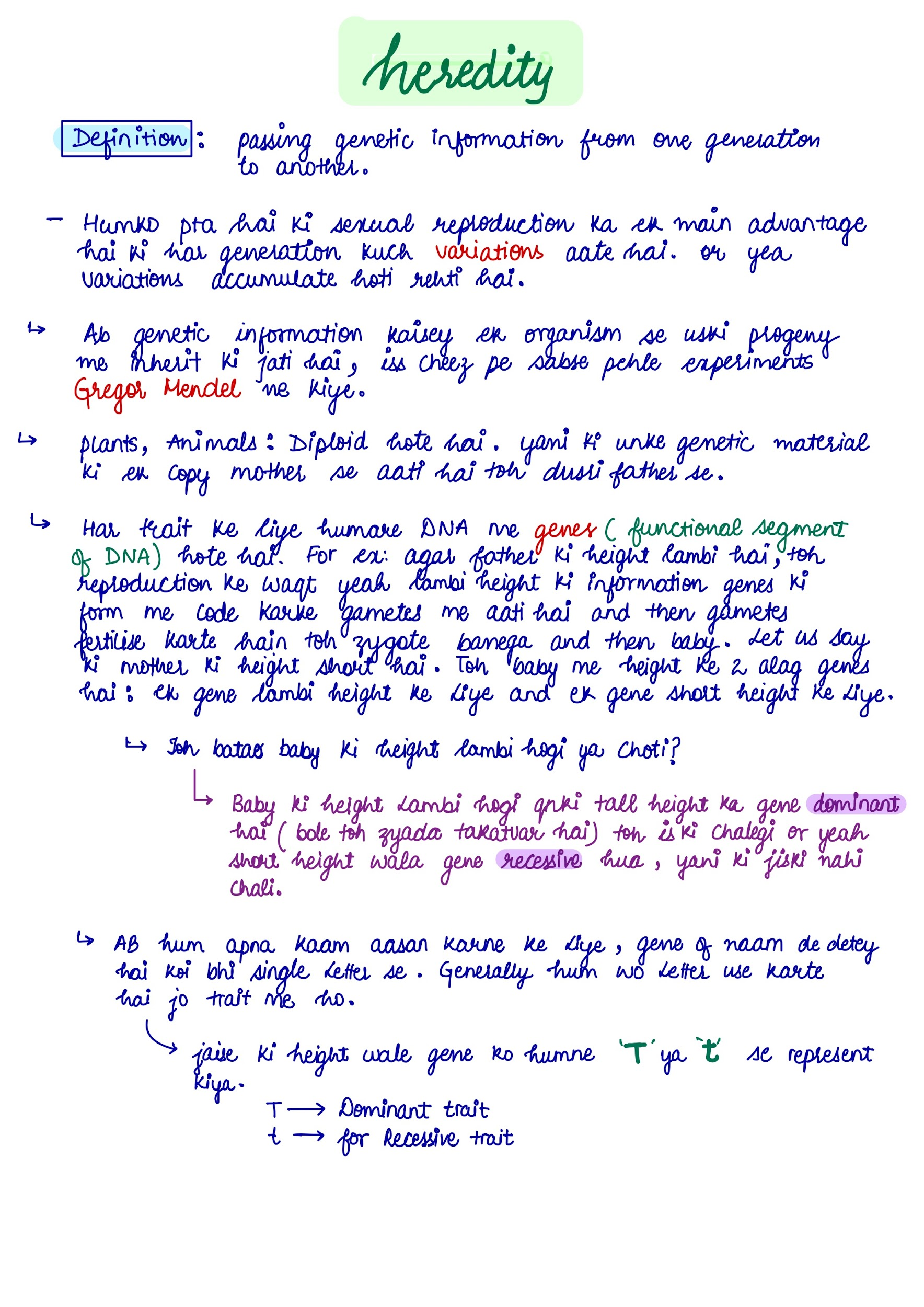
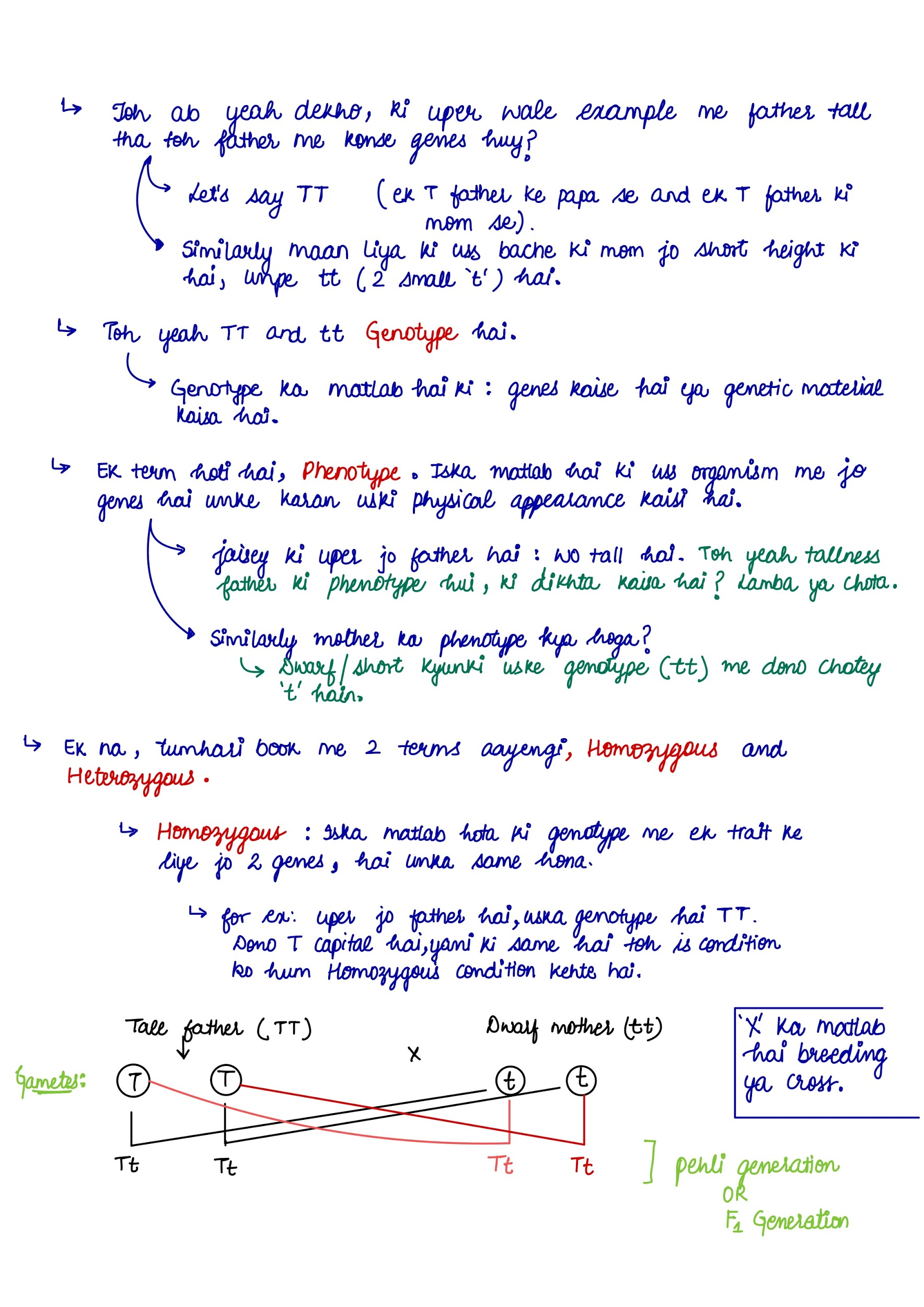

ONE MINUTE REVISION



MENDELIAN GENETICS
- Aaj toh hume pta hai ki har character ke liye humare DNA me genes hote hain and puri genetic information humare DNA me hai. But pehle ke time par biology ke field me itna hume kuch khaas nhi pta tha ki genes kya hote and wo kaise behave karte hain. Humare kuch characters/features father se zyada milte hain and kuch characters mother se. Toh aisa kyon hota tha kisi ko nahi pta tha but aajkal hum bta sakte hain ki aisa isiliye hua kyunki jo character dominant genes se express hote hain keval vhi hume progeny me dikhte hain.
- Genetics ke field me sabse bda breakthrough kiya Gregor Mendel ne and unhone genetics ki puri ek new field ko discover karke uske liye path set kr diya. Mendel ne 1860s me pea plant (Pisum sativum) par kafi salo tak experiment kiya and jo data collect kiya usko mathematical way me probabilities se relate karke present kiya jo ki bahut hi unusual si baat thi uss samay ki dekho isne biology me probability lgadi. But nevertheless he was right about many things. Ab hum unhi ke experiments ko discuss karenge ki unhone kaisey kya kiya.
- Unhone pure breeding pea plant liye and unme self breeding karwane par jo jitni progeny mili uska data record karna shuru kiya. Pure breeding/ true breeding plants aise hote hain jinki progeny unhi ki jaisi hogi. For example agar tall stem height (a character) ke do plants ko unhone apas me breed karwaya toh unki sabhi progeny me unko keval tall stem ke plants hi milenge and inn progeny plants ki progeny bhi tall plants hi create karegi. Unhone aise 7 contrasting pairs me character select kiye. The 7 characters selected by mendel are :
- Stem height
- Flower and pod position
- Pod colour
- Pod shape
- Flower colour
- Seed shape
- Seed colour
Neeche ek image hai ek baar usko read karna and memorize karna ki konse character ka konsa trait dominant hai and konsa recessive hai. Jaisey ki stem height me ‘tall’ stem height dominant hai over dwarf plant. - Ab question yeah aata hai ki Mendel ne pea plant hi kyun choose kiya? Koi or plant kyun nahi? Toh iske simple se 3-4 main reason thy ki
- The flowers of this plant are bisexual.
- They are self-pollinating, toh self and cross pollination can easily be performed.
- The contrasting pair of characters like white and violet flowers, tall and dwarf stem are easily observable characters, so easy to study.
- They have a shorter life span and the plants are easier to maintain.
- They have excellent disease resistance and have an optimal rate of survival.
- Ab in sab experiments se Mendel ne dekha ki hamesha ek character aisa hota hai jo ki sabse zyada population me dekhne ko milta hai hai toh wo dominant character hua. Ab Mendel ko genes ka toh pta nhi tha toh unhone kha ki aise kuch hereditary factors hote hain jo parent se progeny me inherit kiye jate hain and yeah factors pair me present hote hain. Ek pair me se ek factor dominant hota hai and ek factor recessive.
- Mendel ne pehle MONOHYBRID CROSS kiya, yani ki ek character ke against ek character. For example, he crossed true breeding tall stem plant with another true breeding tall plant toh sari ki sari progeny me tall plant mile. Ab jab unhone ek true breeding dwarf ko dusre true breeding dwarf se cross (mate) kiya toh sari progeny dwarf nikli. Next, unhone ek true breeding tall plant ko cross kiya dusre true breeding dwarf plant se (yhaan pe Mendel ne keval ek hi character yani ki stem height ko consider karke apna experiment kiya toh yeah MONOHYBRID CROSS hua. Mono means one) toh progeny me tall or dwarf dono mile wo bhi roughly 3 (Tall) : 1 (Dwarf) ki ratio me. This was the F1 generation. Yahan tak theek tha sab kuch and sense bhi ban rahi thi. Lekin jab unhoneF1 ke tall plants ko apas me breed karwaya (self breeding) toh result me unhe 50% tall and 50% dwarf plant mile. Toh yeah sab data unhone har ek character yani ki flower colour, flower position, seed colour, seed shape etc har ek character ke liye data collect kiya and MONOHYBRID CROSS me hamesha data nearly consistent tha with 3 :1 ratio (phenotypically) in F1 generation and 1:1 ratio in F2 generation.
- Ab iss data se unhone kuch 2-4 conclusion nikale ki ek toh har ek character ke liye ek factor (now known as gene) responsible hota hain. Factors pair me exist karte hain. Pair me se ek dominant hoga and ek recessive. Inhi conclusions pe based unhone genetics ke pehle 2 laws diye :
- LAW OF DOMINANCE (1st LAW) : Heterozygote me ek character ke liye 2 alleles hote hai (in diploid organisms), jinme se ek dominant hota hai and ek recessive.
- LAW OF SEGREGATION (2nd LAW) : yeah law yeah kehta hai ki heterozygote me jo ek character ke liye contrasting pair of alleles hote hain wo gamete formation ke time randomly iss way me segregate hote hai ki half gametes contains one of the two alleles and the other half of the gametes contain the second allele.
- In sab conclusions ke baad issue yeah tha ki yeah sab mathematical cheezein thi toh inko biology se kasiey relate kare. Inhi laws and conclusion ko dhyan me rakhte hue unhone alphabets use kiye. Jo character study karte hain for example stem height, toh iss case jo unko dominant character dikha (by experiments) usko represent kiya by capital 'T' and dwarf stem height recessive hai toh uske liye hum use karte hain ‘t’.
DIHYBRID CROSS - ‘Di’ ka matlab hai 2 and hybrid yani ki characters. Issey pehle Mendel ne keval ek character padha tha like, tall vs. dwarf plant, violet flower color vs. white flower colour etc. but abki baar Mendel ne ek sath 2 contrasting character select kiye wo thy, round and yellow seeded plant with green and wrinkled seeded plant. Toh isko punnett square me represent karte waqt we write RRYY (round & yellow seeds, homozygous) X rryy (wrinkled & green seeds, homozygous). Toh gametes RY and ry banenge respectively. Yahan se aapko first generation F1 ka genotype milega : RrYy (round and yellow, heterozygous). F1 generation me gamete 4 type ke honge : RY, Ry, rY, ry. Toh yahi 4 gamete male me and yhi 4 female me toh we have 16 progenies jinme phenotypic ratio 9 (round yellow) : 3 (round green) : 3 (wrinkled yellow) : 1 (wrinkled green) aata hai.
- OBSERVATION : Dihybrid cross me F1 generation me sabhi round yellow seeds thy and wrinkled green was absent. But F2 generation me yeah recessive character firse appear hua. Ab iska matlab yeah hua ki jo trait F1 me express nahi hua wo next generation me fir se aa gaya along with dominant trait. Yani ki round and wrinkled trait ke genes ek dusre par depend hue bina segregate hue and segregate hony ke bad jis zygote me homozygous recessive condition thi usme wrinkled seeds bn gye else dominant trait (round shape) dikha hume. Toh yahan se genetics ka 3rd law aaya :
LAW OF INDEPENDENT ASSORTMENT : yea law kehta hai ki bhyii jab heterozygous condition me ek character (for example eye color) ke ek pair me contrasting traits (blue eye and green eye color genes) present hote hain toh uss individual me gamete bante waqt yea contrasting trait ek dusre se independently assort hote hain. Yani ki randomly 50% gametes me blue eye colour genes honge and baki ke 50% gametes me green eye colour genes honge. And jab yeah dono eye colour separate honge toh kisi bhi way me blue eye colour ke genes, green eye color genes ke sath interfere nhi karenge which means : independent assortment.
CONCLUSION
Ab yeah sab tha Mendelian genetics yani ki jo bhi Mendel ne experiments kiye and unse data collect karke conclusions nikale. Mendel ne finally conclude kar diya ki sabhi organisms me genetics ke yeah 3 laws follow kiye jayenge. But aisa nahi hua. Mendel ke baad jab or scientists ne dusre plants jaise ki dog flower/Snapdragon/Antirrhinum sp. ke sath yeah hybridisation ke experiments kiye toh results Mendelian results se alag aay. Uske sath jab ye dog flower pe experiments hue toh genetics ki field badh chuki thi and kuch gentic phenomenon jaisey ki blood groups vgarah codominance show karte hain jo Mendelian genetics se alag hain. Mendel galat nahi tha but kuch phenomenon Mendelian genetics ka exception hote hain. Aisey hi 2 phenomenon : Incomplete Dominance & Codominance wo exception hain jo hum CBSE me study karenge. Aur bhi exceptions hai like Epistasis but wo CBSE ke syllabus me nahi hai and yeah thoda sa complex bhi hai. Toh we will only study about incomplete dominance and codominance.
MENDELIAN PERIOD
- MENDEL’S LIFE
- Gregor Johann Mendel was born on July 22, in 1822 in Silesian, a village in Heinzendorf (Austria).
- He was first geneticist and also known as The Father of Genetics.
- In 1843, because of poverty, Mendel joined the Augustinian monastery of St. Thomas at Brunn.
- Then he went to the University of Vienna for the study of natural sciences and mathematics. → Mendel returned to Brunn as a substitute teacher of science.
- He observed that pea plants growing in his monastery produced two types of seeds. → This made him interested in pea plants and then he set out to study the effect of hybridization between different varieties.
- Hybridization In 1859-1864, he selected pure breeding varieties or pure lines of pea and performed various types of cross and self breeding experiments.
- Pure or True Breeding Varieties are those plants which produce offspring with the same traits on self-pollination.
- In 1866, his papers “Experiments on Plant Hybridisation” was published in fourth volume of“Proceedings of Brunn Natural History Society”.
- Mendel’s discoveries during his lifetime remained unnoticed and was not appreciated by contemporary biologists, because:
- His work was far ahead of his time.
- Limited distribution of journal in which his work was published.
- He was himself not sure of his findings, as he failed to get similar results on hawkweed (Hieracium).
- His mathematical approach in working out biological problems was strange for the scientists of that time.
- Mind of the biologists was preoccupied with Darwin's theory of evolution.
- Mendel died in 1884 and his work was rediscovered in 1900 by three biologists:Hugo De Vries, Carl Correns, and Tschermak.
- Bateson and Punnet later confirmed Mendel's work to be of universal application including animals.
- Annual plant with a short life cycle, because of this one can study several generations within a short period.
- Pea plants flowers normally remain closed and undergo self-pollination, because of self-fertilization plants are usually homozygous.
- Flowers are bisexual it is easy to perform Cross-Pollination or Artificial-Hybridisation technique.
→Pollens from the flower of one plant can be easily transferred to the stigma of another flower by removing anthers (emasculation) and bagging stigma. - They show a number of definite and easily detectable contrasting characters:
→Some plants were tall while others were short and bushy.
→Some of them produce coloured flowers whereas some produce white. - Pisum sativum produce large numbers of seeds in one generation.
- It can be easily handled, maintained, and raised.
- Pea plants having each of seven characters Mendel selected were readily available.
- SELECTION OF PURE PARENT PLANTS
- Mendel selected 7 pairs of true breeding varieties, that is, they were passed on from parents to offspring.
- All traits had easily distinguishable alternate forms e.g., tallness and dwarfness, Coloured or white seeds etc.
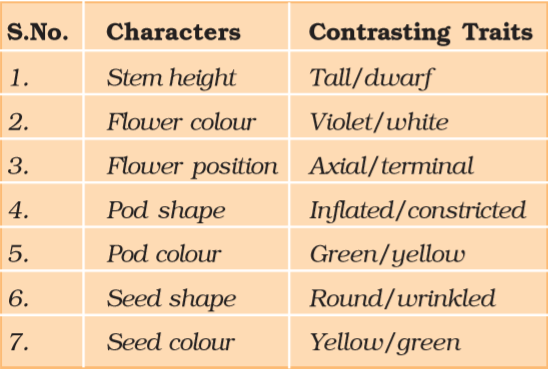
(NOTE: For obtaining pure plants, he raised seeds by self-pollination from pea plants having different traits and sowed them in his garden.
The plants that grew from these seeds showed that each trait of seven characters was handed down by the parents to the offspring.
Seeds from tall plants produced tall plants, and yellow seeds produced plants with yellow seeds, and so on. Mendel called each of these a pure trait.) - HYBRIDIZATION OF PURE PLANT
- Hybridization refers to crossing or mating of two varieties of plants or animals.
- In this step, Mendel crossed two pure breeding plants having contrasting traits of the characters. For example:→Cross between tall and dwarf for size.
→Cross between red and white flowers for colour. - Here, the flowers of one plant (Tall Trait) were emasculated (Removal of Anthers) and Pollens are dusted from the flower of another plant (Dwarf Trait) on the stigmas of tall plants.
- These artificially pollinated flowers were covered by the paper bag to avoid contamination by unwanted pollen.
- The seeds produced by these plants were collected and plants were raised from seeds next year.
- The generation of these plants is named as First Filial Generation, represented by F1 symbol.
NOTE: Filial Refers to Offspring. - SELF POLLINATION IN HYBRIDS
- In this step, the plants of F1 generation were subjected to self-pollination.
- For this, their flowers were enclosed in paper bags to keep out foreign pollen.
- The seeds produced were collected and sown.
- They produced second-generation named second filial generation, indicated by the symbol F2.
- Self-pollination in F2 gave rise to the third generation referred to as the third filial generation, indicated by the symbol F3, and so on.
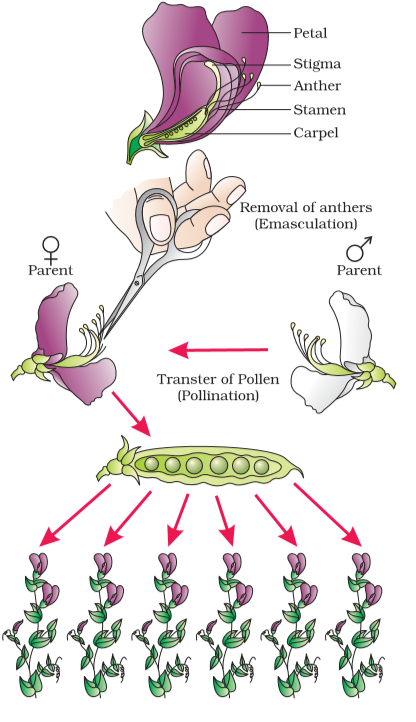
- Mendel selected only pure breeding varieties of Pea for his experiments. He took two years to check that his experimental plants are pure breeding.
- Mendel studied only those traits which did not show linkage or incomplete dominance.
- Mendel took one or two characters at one time.
- Pea is ideal for controlled hybridization. It is cross-bred manually while normally it undergoes self breeding.
- He took care to avoid contamination from foreign pollen grains brought by insects.
- Mendel kept a complete record of all the crosses and their results.
- He formulated theoretical explanations for interpreting his results. His explanations were further tested by him for their validity.
- Mendel used statistical methods and law of probability for analyzing his results.
- Mendel was lucky in selecting those traits, the genes of which were either present on different chromosomes or showed complete recombination.
- He did not attempt to explain all the variations found in his results but left them as such.
- Characters chosen by Mendel had distinctive contrasting traits like tall and dwarf or green and yellow.
- Mendel studied the inheritance of a character for three or more generations.
- He performed reciprocal crosses and raised large progenies.
NOTE
REDISCOVERY OF MENDEL’S WORK
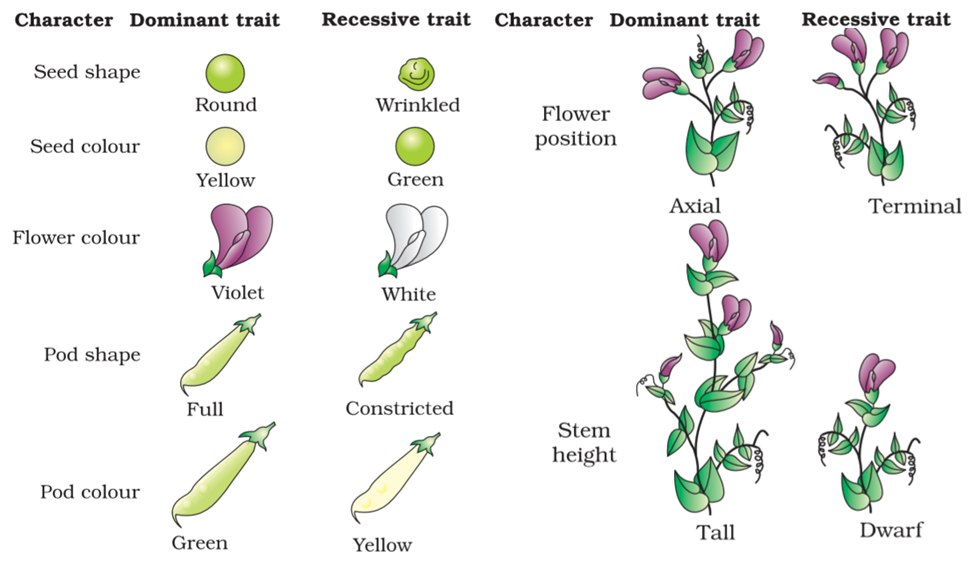
MENDEL’S EXPERIMENTAL PLANT
Mendel selected garden Pea Plant (Pisum sativum) and worked on this plant because of below mentioned advantages:
MENDEL’S EXPERIMENTAL TECHNIQUE
Mendel performed breathing experiments in three steps:
REASONS FOR MENDEL SUCCESS
MENDELIAN PERIOD
- MENDEL’S LIFE
- Gregor Johann Mendel was born on July 22, in 1822 in Silesian, a village in Heinzendorf (Austria).
- He was first geneticist and also known as The Father of Genetics.
- In 1843, because of poverty, Mendel joined the Augustinian monastery of St. Thomas at Brunn.
- Then he went to the University of Vienna for the study of natural sciences and mathematics. → Mendel returned to Brunn as a substitute teacher of science.
- He observed that pea plants growing in his monastery produced two types of seeds. → This made him interested in pea plants and then he set out to study the effect of hybridization between different varieties.
- Hybridization In 1859-1864, he selected pure breeding varieties or pure lines of pea and performed various types of cross and self breeding experiments.
- Pure or True Breeding Varieties are those plants which produce offspring with the same traits on self-pollination.
- In 1866, his papers “Experiments on Plant Hybridisation” was published in fourth volume of“Proceedings of Brunn Natural History Society”.
- Mendel’s discoveries during his lifetime remained unnoticed and was not appreciated by contemporary biologists, because:
- His work was far ahead of his time.
- Limited distribution of journal in which his work was published.
- He was himself not sure of his findings, as he failed to get similar results on hawkweed (Hieracium).
- His mathematical approach in working out biological problems was strange for the scientists of that time.
- Mind of the biologists was preoccupied with Darwin's theory of evolution.
- Mendel died in 1884 and his work was rediscovered in 1900 by three biologists:Hugo De Vries, Carl Correns, and Tschermak.
- Bateson and Punnet later confirmed Mendel's work to be of universal application including animals.
- Annual plant with a short life cycle, because of this one can study several generations within a short period.
- Pea plants flowers normally remain closed and undergo self-pollination, because of self-fertilization plants are usually homozygous.
- Flowers are bisexual it is easy to perform Cross-Pollination or Artificial-Hybridisation technique.
→Pollens from the flower of one plant can be easily transferred to the stigma of another flower by removing anthers (emasculation) and bagging stigma. - They show a number of definite and easily detectable contrasting characters:
→Some plants were tall while others were short and bushy.
→Some of them produce coloured flowers whereas some produce white. - Pisum sativum produce large numbers of seeds in one generation.
- It can be easily handled, maintained, and raised.
- Pea plants having each of seven characters Mendel selected were readily available.
- SELECTION OF PURE PARENT PLANTS
- Mendel selected 7 pairs of true breeding varieties, that is, they were passed on from parents to offspring.
- All traits had easily distinguishable alternate forms e.g., tallness and dwarfness, Coloured or white seeds etc.

(NOTE: For obtaining pure plants, he raised seeds by self-pollination from pea plants having different traits and sowed them in his garden.
The plants that grew from these seeds showed that each trait of seven characters was handed down by the parents to the offspring.
Seeds from tall plants produced tall plants, and yellow seeds produced plants with yellow seeds, and so on. Mendel called each of these a pure trait.) - HYBRIDIZATION OF PURE PLANT
- Hybridization refers to crossing or mating of two varieties of plants or animals.
- In this step, Mendel crossed two pure breeding plants having contrasting traits of the characters. For example:→Cross between tall and dwarf for size.
→Cross between red and white flowers for colour. - Here, the flowers of one plant (Tall Trait) were emasculated (Removal of Anthers) and Pollens are dusted from the flower of another plant (Dwarf Trait) on the stigmas of tall plants.
- These artificially pollinated flowers were covered by the paper bag to avoid contamination by unwanted pollen.
- The seeds produced by these plants were collected and plants were raised from seeds next year.
- The generation of these plants is named as First Filial Generation, represented by F1 symbol.
NOTE: Filial Refers to Offspring. - SELF POLLINATION IN HYBRIDS
- In this step, the plants of F1 generation were subjected to self-pollination.
- For this, their flowers were enclosed in paper bags to keep out foreign pollen.
- The seeds produced were collected and sown.
- They produced second-generation named second filial generation, indicated by the symbol F2.
- Self-pollination in F2 gave rise to the third generation referred to as the third filial generation, indicated by the symbol F3, and so on.

- Mendel selected only pure breeding varieties of Pea for his experiments. He took two years to check that his experimental plants are pure breeding.
- Mendel studied only those traits which did not show linkage or incomplete dominance.
- Mendel took one or two characters at one time.
- Pea is ideal for controlled hybridization. It is cross-bred manually while normally it undergoes self breeding.
- He took care to avoid contamination from foreign pollen grains brought by insects.
- Mendel kept a complete record of all the crosses and their results.
- He formulated theoretical explanations for interpreting his results. His explanations were further tested by him for their validity.
- Mendel used statistical methods and law of probability for analyzing his results.
- Mendel was lucky in selecting those traits, the genes of which were either present on different chromosomes or showed complete recombination.
- He did not attempt to explain all the variations found in his results but left them as such.
- Characters chosen by Mendel had distinctive contrasting traits like tall and dwarf or green and yellow.
- Mendel studied the inheritance of a character for three or more generations.
- He performed reciprocal crosses and raised large progenies.
NOTE
REDISCOVERY OF MENDEL’S WORK

MENDEL’S EXPERIMENTAL PLANT
Mendel selected garden Pea Plant (Pisum sativum) and worked on this plant because of below mentioned advantages:
MENDEL’S EXPERIMENTAL TECHNIQUE
Mendel performed breathing experiments in three steps:
REASONS FOR MENDEL SUCCESS
ONE MINUTE REVISION



MENDEL’S MONOHYBRID CROSS
- INHERITANCE OF ONE GENE
- Mendel initiated his study with the inheritance of a single character at a time.
→ A breeding experiment dealing with one character at a time is called a monohybrid cross. - One such experiment is outlined below:
- Mendel hybridized a pure tall (100-120cm high) pea plant with pure dwarf (22-24 cm high) pea plant. Mendel called them parental generation, represented by P.
- He collected seeds produced by the parental generation and grew plants from them.
- He found that all plants were tall. None of them was intermediate or dwarf in size.
- These tall plants constituted the F1 generation.
- The tall F1 plants produced from parental generation were pollinated among themselves or allowed to undergo self-pollination.
- The flowers were covered from beginning to prevent contamination from other unwanted pollen grains.
- Again he collected seeds produced from F1 plants and grew plants from them, these plants constituted F2 generation.
- The F2 plants were found to contain both tall and dwarf individuals. They were in the ratio of three tall to one dwarf.
- This indicates that the F1 plants had a trait for tallness as well as a trait for dwarfness.
- Such genetically mixed offspring produced by crossing two pure parents having contrasting traits are called hybrids.
- The whole same process was again repeated i.e. F2 plants were allowed to self pollinate, seeds collected and new plants were grown from those seeds.
- Results were also the same, that is we got tall and dwarf plants. However, these plants behaved differently.
- The Dwarf plants bred true i.e. they produced dwarf plants on self-pollination.
- Out of total tall plants: →One third bred true i.e. produced tall plants.
- F1 plants produced by hybridization between pure tall and dwarf plants express only one of the contrasting traits, i.e either tall or dwarf (Resemble only one parent).
→One of the two contrasting traits of character remains unexpressed or hidden in F1 generation. - No F1 plant is intermediate between the two alternative traits of parents.
- In F2 generation or plants both contracting traits appear.
→Three-fourth plants are tall and the remaining one-fourth are dwarf. - Gametes brings from parents something that is stably passed unchanged, from parent to offspring, over successive generations.
- This something was referred to as Factor by him, the latter is responsible for the appearance of the character in the next generation.
- In 1909 Johannsen, The Danish Botanist used the term Gene instead of factors. →In 1912 Morgan, The American Geneticist showed that genes are present or carried on the chromosomes.
- Certain factors in individuals do not express their characters, such factors remain unchanged and express themselves in the next (later) generation.
- For example: In F1 generation factor for factor for dwarfness doesn’t appear however it appeared in F2.
- the two mendelian factors present in the F1 plants segregate during gamete formation.
- Gametes carry a single factor for a trait.
- The factors get distributed randomly in the offspring due to chance fusion of gametes during fertilization.
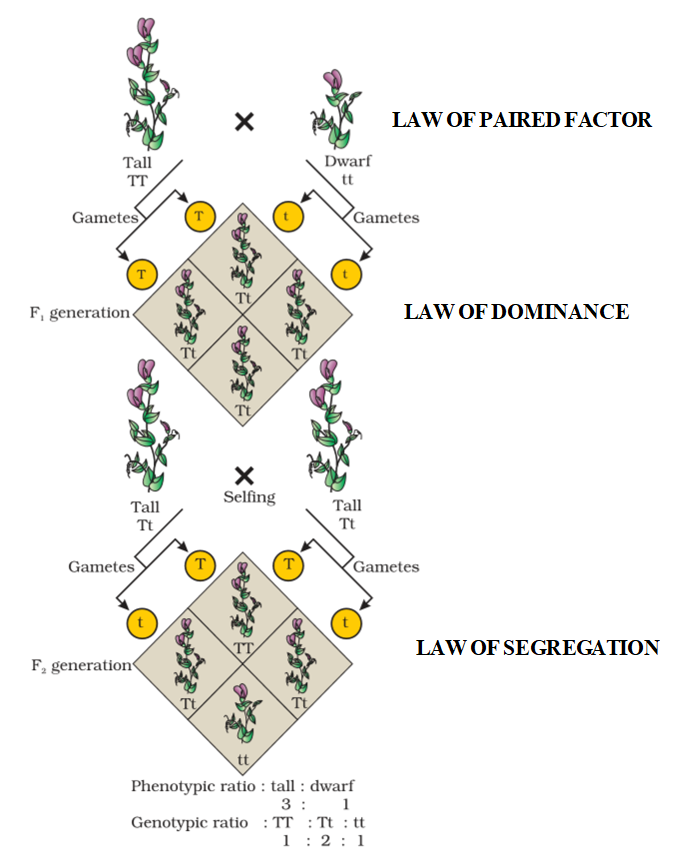
F1 GENERATION
NOTE: The results were the same in case of reciprocal cross too.
→ Reciprocal Crosses : A reciprocal cross involves the same traits but carried by sexes opposite to those in the original or first cross. For example, if in the original cross, pollen from the flowers of a tall pea plant were transferred to stigmas of the flowers of a dwarf plant; in a reciprocal cross, pollen from the flowers of a dwarf plant is deposited on the stigmas of the flowers of a tall plant.
F2 GENERATION
F3 GENERATION
→The rest behaved like F1 plants and produced three tall and one dwarf plants.
NOTE: Thus we can say the ratio of a monohybrid cross is 3:1.
OUTCOME OF MONOHYBRID CROSS
CONCLUSIONS DRAWN FROM THE MONOHYBRID CROSS
CONCLUSION I
NOTE: There are pairs of factors for each character, one inherited from each parent.
PRINCIPLE OF UNIT OR PAIRED FACTORS
Statement
→This law/principle was formulated on the basis of the conclusion (Conclusion I).
→This law states that in diploid organisms various hereditary characters are controlled by factors or two alleles that lie on two homologous chromosomes at the same locus.
Explanation
→An individual receives one allele/factor for a trait from each parent, and, in turn, passes one of the two alleles/factor for a trait at random to each offspring.
→In a homozygous individual the two alleles are similar for a trait e.g. TT for a pure tall plant whereas in the heterozygous individual the alleles are different e.g. Tt for hybrid tall pea plant.
CONCLUSION II
PRINCIPLE OF DOMINANCE (MENDEL’S FIRST LAW)
Statement
→This law/principle was formulated on the basis of the conclusion (Conclusion II).
→This states that in heterozygous individuals, a character is represented by two contrasting factors/alleles.
→Out of the two alleles, only one is able to express itself and is called dominant allele. The other allele, which does not show its effect, is called recessive allele.
Explanation
→Take two Pea plants, one pure or homozygous tall(TT) and the other pure or homozygous dwarf (tt).
→Cross the two and raise the F1 generation. All plants of theF1 generation are tall though they have also received a factor for dwarfness (Tt).
→The factor for dwarfness is present in F1 plants can be tested by self-breeding them.
→In F2 generation individuals will be both fall and dwarf in the ratio of 3:1.
→Therefore, in F1 plants both the factors for tallness and dwarfness, are present.
→ However, the factor for dwarfness is unable to express itself in the presence of factor for tallness.
EXPLANATION
The principle of segregation can be deduced from the monohybrid cross shown in the figure:
→Though F1 plants show only the dominant character of a trait, it carries factors of both the characters. Therefore, F1, plants are genetically heterozygous.
→F1 plants are a product of the fusion of male and female gametes. As they have a genotypic composition of Tt, the fusing gametes must bring in only one factor each (T from TT and t from tt parent).
→F2 generation consists of three types of plants - pure tall, hybrid tall and dwarf.
This is possible when:
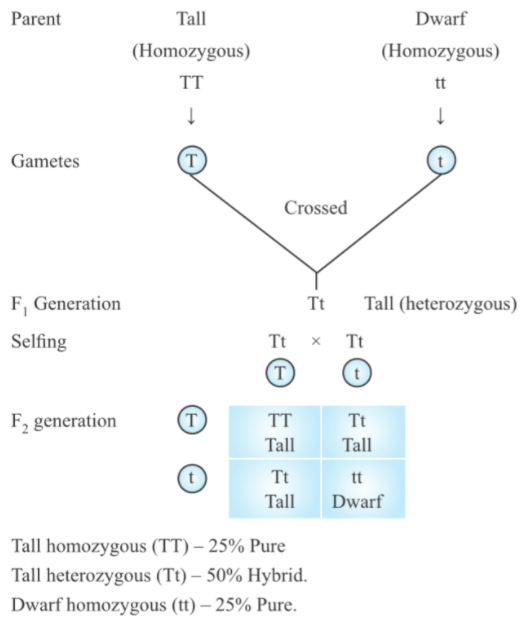
THE LAW OF SEGREGATION
Statement
→This law/principle was formulated on the basis of both the conclusions.
→This law states that the two factors/alleles of characters segregate (separate) during gamete formation so that each gamete receives only one factor/allele for each character.
→ Since the gametes possess one allele of each character, they are always pure therefore this law is also known as the Law of Purity of Gametes or Non-Mixing of Alleles.
MENDEL’S MONOHYBRID CROSS
- INHERITANCE OF ONE GENE
- Mendel initiated his study with the inheritance of a single character at a time.
→ A breeding experiment dealing with one character at a time is called a monohybrid cross. - One such experiment is outlined below:
- Mendel hybridized a pure tall (100-120cm high) pea plant with pure dwarf (22-24 cm high) pea plant. Mendel called them parental generation, represented by P.
- He collected seeds produced by the parental generation and grew plants from them.
- He found that all plants were tall. None of them was intermediate or dwarf in size.
- These tall plants constituted the F1 generation.
- The tall F1 plants produced from parental generation were pollinated among themselves or allowed to undergo self-pollination.
- The flowers were covered from beginning to prevent contamination from other unwanted pollen grains.
- Again he collected seeds produced from F1 plants and grew plants from them, these plants constituted F2 generation.
- The F2 plants were found to contain both tall and dwarf individuals. They were in the ratio of three tall to one dwarf.
- This indicates that the F1 plants had a trait for tallness as well as a trait for dwarfness.
- Such genetically mixed offspring produced by crossing two pure parents having contrasting traits are called hybrids.
- The whole same process was again repeated i.e. F2 plants were allowed to self pollinate, seeds collected and new plants were grown from those seeds.
- Results were also the same, that is we got tall and dwarf plants. However, these plants behaved differently.
- The Dwarf plants bred true i.e. they produced dwarf plants on self-pollination.
- Out of total tall plants: →One third bred true i.e. produced tall plants.
- F1 plants produced by hybridization between pure tall and dwarf plants express only one of the contrasting traits, i.e either tall or dwarf (Resemble only one parent).
→One of the two contrasting traits of character remains unexpressed or hidden in F1 generation. - No F1 plant is intermediate between the two alternative traits of parents.
- In F2 generation or plants both contracting traits appear.
→Three-fourth plants are tall and the remaining one-fourth are dwarf. - Gametes brings from parents something that is stably passed unchanged, from parent to offspring, over successive generations.
- This something was referred to as Factor by him, the latter is responsible for the appearance of the character in the next generation.
- In 1909 Johannsen, The Danish Botanist used the term Gene instead of factors. →In 1912 Morgan, The American Geneticist showed that genes are present or carried on the chromosomes.
- Certain factors in individuals do not express their characters, such factors remain unchanged and express themselves in the next (later) generation.
- For example: In F1 generation factor for factor for dwarfness doesn’t appear however it appeared in F2.
- the two mendelian factors present in the F1 plants segregate during gamete formation.
- Gametes carry a single factor for a trait.
- The factors get distributed randomly in the offspring due to chance fusion of gametes during fertilization.

F1 GENERATION
NOTE: The results were the same in case of reciprocal cross too.
→ Reciprocal Crosses : A reciprocal cross involves the same traits but carried by sexes opposite to those in the original or first cross. For example, if in the original cross, pollen from the flowers of a tall pea plant were transferred to stigmas of the flowers of a dwarf plant; in a reciprocal cross, pollen from the flowers of a dwarf plant is deposited on the stigmas of the flowers of a tall plant.
F2 GENERATION
F3 GENERATION
→The rest behaved like F1 plants and produced three tall and one dwarf plants.
NOTE: Thus we can say the ratio of a monohybrid cross is 3:1.
OUTCOME OF MONOHYBRID CROSS
CONCLUSIONS DRAWN FROM THE MONOHYBRID CROSS
CONCLUSION I
NOTE: There are pairs of factors for each character, one inherited from each parent.
PRINCIPLE OF UNIT OR PAIRED FACTORS
Statement
→This law/principle was formulated on the basis of the conclusion (Conclusion I).
→This law states that in diploid organisms various hereditary characters are controlled by factors or two alleles that lie on two homologous chromosomes at the same locus.
Explanation
→An individual receives one allele/factor for a trait from each parent, and, in turn, passes one of the two alleles/factor for a trait at random to each offspring.
→In a homozygous individual the two alleles are similar for a trait e.g. TT for a pure tall plant whereas in the heterozygous individual the alleles are different e.g. Tt for hybrid tall pea plant.
CONCLUSION II
PRINCIPLE OF DOMINANCE (MENDEL’S FIRST LAW)
Statement
→This law/principle was formulated on the basis of the conclusion (Conclusion II).
→This states that in heterozygous individuals, a character is represented by two contrasting factors/alleles.
→Out of the two alleles, only one is able to express itself and is called dominant allele. The other allele, which does not show its effect, is called recessive allele.
Explanation
→Take two Pea plants, one pure or homozygous tall(TT) and the other pure or homozygous dwarf (tt).
→Cross the two and raise the F1 generation. All plants of theF1 generation are tall though they have also received a factor for dwarfness (Tt).
→The factor for dwarfness is present in F1 plants can be tested by self-breeding them.
→In F2 generation individuals will be both fall and dwarf in the ratio of 3:1.
→Therefore, in F1 plants both the factors for tallness and dwarfness, are present.
→ However, the factor for dwarfness is unable to express itself in the presence of factor for tallness.
EXPLANATION
The principle of segregation can be deduced from the monohybrid cross shown in the figure:
→Though F1 plants show only the dominant character of a trait, it carries factors of both the characters. Therefore, F1, plants are genetically heterozygous.
→F1 plants are a product of the fusion of male and female gametes. As they have a genotypic composition of Tt, the fusing gametes must bring in only one factor each (T from TT and t from tt parent).
→F2 generation consists of three types of plants - pure tall, hybrid tall and dwarf.
This is possible when:

THE LAW OF SEGREGATION
Statement
→This law/principle was formulated on the basis of both the conclusions.
→This law states that the two factors/alleles of characters segregate (separate) during gamete formation so that each gamete receives only one factor/allele for each character.
→ Since the gametes possess one allele of each character, they are always pure therefore this law is also known as the Law of Purity of Gametes or Non-Mixing of Alleles.
MENDELIAN PERIOD
MENDEL’S LIFE
- Gregor Johann Mendel was born on July 22, in 1822 in Silesian, a village in Heinzendorf (Austria).
- He was first geneticist and also known as The Father of Genetics.
- In 1843, because of poverty, Mendel joined the Augustinian monastery of St. Thomas at Brunn.
- Then he went to the University of Vienna for the study of natural sciences and mathematics. → Mendel returned to Brunn as a substitute teacher of science.
- He observed that pea plants growing in his monastery produced two types of seeds. → This made him interested in pea plants and then he set out to study the effect of hybridization between different varieties.
- Hybridization In 1859-1864, he selected pure breeding varieties or pure lines of pea and performed various types of cross and self breeding experiments.
- Pure or True Breeding Varieties are those plants which produce offspring with the same traits on self-pollination.
- In 1866, his papers “Experiments on Plant Hybridisation” was published in fourth volume of“Proceedings of Brunn Natural History Society”.
- Mendel’s discoveries during his lifetime remained unnoticed and was not appreciated by contemporary biologists, because:
- His work was far ahead of his time.
- Limited distribution of journal in which his work was published.
- He was himself not sure of his findings, as he failed to get similar results on hawkweed (Hieracium).
- His mathematical approach in working out biological problems was strange for the scientists of that time.
- Mind of the biologists was preoccupied with Darwin's theory of evolution.
- Mendel died in 1884 and his work was rediscovered in 1900 by three biologists:Hugo De Vries, Carl Correns, and Tschermak.
- Bateson and Punnet later confirmed Mendel's work to be of universal application including animals.
- Annual plant with a short life cycle, because of this one can study several generations within a short period.
- Pea plants flowers normally remain closed and undergo self-pollination, because of self-fertilization plants are usually homozygous.
- Flowers are bisexual it is easy to perform Cross-Pollination or Artificial-Hybridisation technique.
→Pollens from the flower of one plant can be easily transferred to the stigma of another flower by removing anthers (emasculation) and bagging stigma. - They show a number of definite and easily detectable contrasting characters:
→Some plants were tall while others were short and bushy.
→Some of them produce coloured flowers whereas some produce white. - Pisum sativum produce large numbers of seeds in one generation.
- It can be easily handled, maintained, and raised.
- Pea plants having each of seven characters Mendel selected were readily available.
- SELECTION OF PURE PARENT PLANTS
- Mendel selected 7 pairs of true breeding varieties, that is, they were passed on from parents to offspring.
- All traits had easily distinguishable alternate forms e.g., tallness and dwarfness, Coloured or white seeds etc.

(NOTE: For obtaining pure plants, he raised seeds by self-pollination from pea plants having different traits and sowed them in his garden.
The plants that grew from these seeds showed that each trait of seven characters was handed down by the parents to the offspring.
Seeds from tall plants produced tall plants, and yellow seeds produced plants with yellow seeds, and so on. Mendel called each of these a pure trait.) - HYBRIDIZATION OF PURE PLANT
- Hybridization refers to crossing or mating of two varieties of plants or animals.
- In this step, Mendel crossed two pure breeding plants having contrasting traits of the characters. For example:→Cross between tall and dwarf for size.
→Cross between red and white flowers for colour. - Here, the flowers of one plant (Tall Trait) were emasculated (Removal of Anthers) and Pollens are dusted from the flower of another plant (Dwarf Trait) on the stigmas of tall plants.
- These artificially pollinated flowers were covered by the paper bag to avoid contamination by unwanted pollen.
- The seeds produced by these plants were collected and plants were raised from seeds next year.
- The generation of these plants is named as First Filial Generation, represented by F1 symbol.
NOTE: Filial Refers to Offspring. - SELF POLLINATION IN HYBRIDS
- In this step, the plants of F1 generation were subjected to self-pollination.
- For this, their flowers were enclosed in paper bags to keep out foreign pollen.
- The seeds produced were collected and sown.
- They produced second-generation named second filial generation, indicated by the symbol F2.
- Self-pollination in F2 gave rise to the third generation referred to as the third filial generation, indicated by the symbol F3, and so on.

NOTE
REDISCOVERY OF MENDEL’S WORK

MENDEL’S EXPERIMENTAL PLANT
Mendel selected garden Pea Plant (Pisum sativum) and worked on this plant because of below mentioned advantages:
MENDEL’S EXPERIMENTAL TECHNIQUE
Mendel performed breathing experiments in three steps:
REASONS FOR MENDEL SUCCESS
MENDEL’S DIHYBRID CROSS
- INHERITANCE OF TWO GENES
- After the inheritance of one gene, Mendel also studied the inheritance of two characters simultaneously.
→ A breeding experiment dealing with the inheritance of two pairs of contrasting characters at the same time is called a dihybrid cross. - He hybridized a pea plant having round seed and yellow cotyledon with a pea plant having wrinkled seeds and green cotyledon.
- He got all the plants in F1 with round seeds and yellow cotyledons.
- F1 plants are allowed to self-pollinate, it results in the production of a total 16 number of plants.
OUTCOME OF DIHYBRID CROSS
- Four different types of plants in F2 generation
- 9 had round seeds and yellow cotyledons.
- 3 had round seeds and green cotyledons.
- 3 had yellow cotyledons and wrinkled seeds.
- 1 had green cotyledons and wrinkled seeds.
- Among four kinds of F2 plants:
NOTE
→ Thus the phenotypic ratio of a dihybrid cross is 9:3:3:1.
→ Genotypic ratio of a dihybrid cross is 1:2:2:4:1:2:1:2:1.
→ The two with round and yellow seeds and wrinkled and green seeds had parental combinations.
→ The other two with round and green seeds and wrinkled and green seeds had new combinations.
CONCLUSIONS DRAWN FROM THE DIHYBRID CROSS
- CONCLUSION
The inheritance of seed shape was independent of the inheritance of cotyledon colour.
LAW OF INDEPENDENT ASSORTMENT
Statement
It states that when two pairs of contrasting traits are combined in a hybrid, segregation of one pair of characters is independent of the other pair of characters. These factors randomly rearrange in the offsprings producing both parental and new combinations of characters.
NOTE: Law of segregation and Independent Assortment are universally applicable, whereas other principles have some exceptions.
Explanation
It can be understood with the help of dihybrid cross given below:
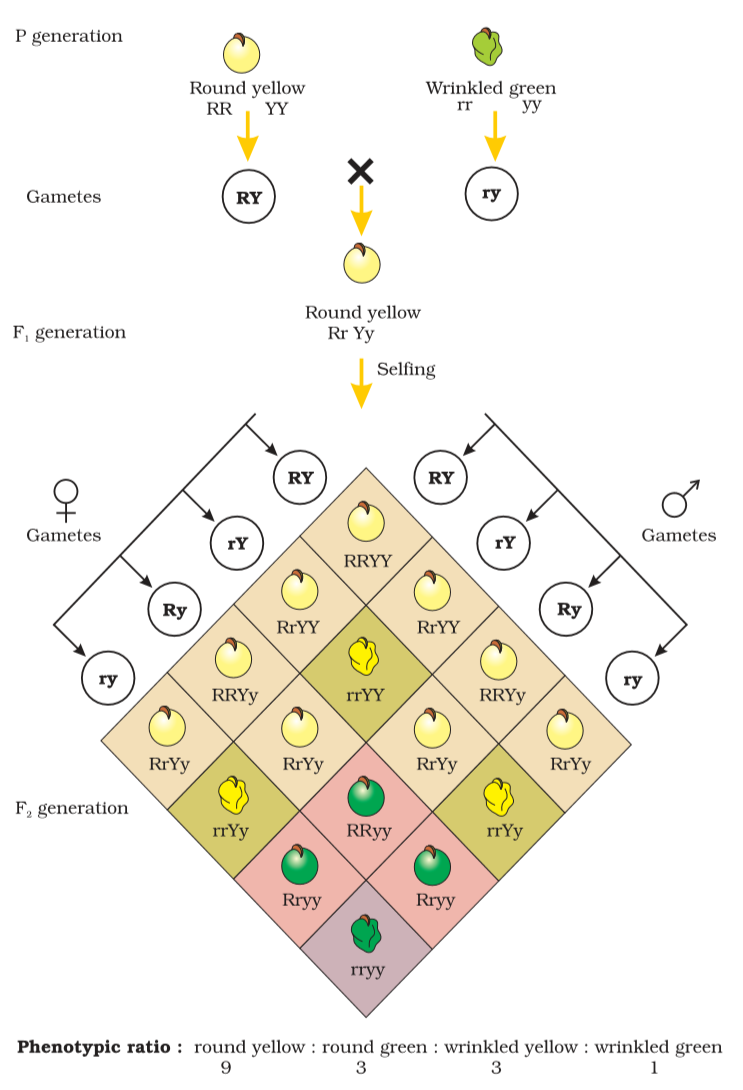
MENDEL’S DIHYBRID CROSS
- INHERITANCE OF TWO GENES
- After the inheritance of one gene, Mendel also studied the inheritance of two characters simultaneously.
→ A breeding experiment dealing with the inheritance of two pairs of contrasting characters at the same time is called a dihybrid cross. - He hybridized a pea plant having round seed and yellow cotyledon with a pea plant having wrinkled seeds and green cotyledon.
- He got all the plants in F1 with round seeds and yellow cotyledons.
- F1 plants are allowed to self-pollinate, it results in the production of a total 16 number of plants.
OUTCOME OF DIHYBRID CROSS
- Four different types of plants in F2 generation
- 9 had round seeds and yellow cotyledons.
- 3 had round seeds and green cotyledons.
- 3 had yellow cotyledons and wrinkled seeds.
- 1 had green cotyledons and wrinkled seeds.
- Among four kinds of F2 plants:
NOTE
→ Thus the phenotypic ratio of a dihybrid cross is 9:3:3:1.
→ Genotypic ratio of a dihybrid cross is 1:2:2:4:1:2:1:2:1.
→ The two with round and yellow seeds and wrinkled and green seeds had parental combinations.
→ The other two with round and green seeds and wrinkled and green seeds had new combinations.
CONCLUSIONS DRAWN FROM THE DIHYBRID CROSS
- CONCLUSION
The inheritance of seed shape was independent of the inheritance of cotyledon colour.
LAW OF INDEPENDENT ASSORTMENT
Statement
It states that when two pairs of contrasting traits are combined in a hybrid, segregation of one pair of characters is independent of the other pair of characters. These factors randomly rearrange in the offsprings producing both parental and new combinations of characters.
NOTE: Law of segregation and Independent Assortment are universally applicable, whereas other principles have some exceptions.
Explanation
It can be understood with the help of dihybrid cross given below:

MENDEL’S MONOHYBRID CROSS
INHERITANCE OF ONE GENE
- Mendel initiated his study with the inheritance of a single character at a time.
→ A breeding experiment dealing with one character at a time is called a monohybrid cross. - One such experiment is outlined below:
- Mendel hybridized a pure tall (100-120cm high) pea plant with pure dwarf (22-24 cm high) pea plant. Mendel called them parental generation, represented by P.
- He collected seeds produced by the parental generation and grew plants from them.
- He found that all plants were tall. None of them was intermediate or dwarf in size.
- These tall plants constituted the F1 generation.
- The tall F1 plants produced from parental generation were pollinated among themselves or allowed to undergo self-pollination.
- The flowers were covered from beginning to prevent contamination from other unwanted pollen grains.
- Again he collected seeds produced from F1 plants and grew plants from them, these plants constituted F2 generation.
- The F2 plants were found to contain both tall and dwarf individuals. They were in the ratio of three tall to one dwarf.
- This indicates that the F1 plants had a trait for tallness as well as a trait for dwarfness.
- Such genetically mixed offspring produced by crossing two pure parents having contrasting traits are called hybrids.
- The whole same process was again repeated i.e. F2 plants were allowed to self pollinate, seeds collected and new plants were grown from those seeds.
- Results were also the same, that is we got tall and dwarf plants. However, these plants behaved differently.
- The Dwarf plants bred true i.e. they produced dwarf plants on self-pollination.
- Out of total tall plants: →One third bred true i.e. produced tall plants.
- F1 plants produced by hybridization between pure tall and dwarf plants express only one of the contrasting traits, i.e either tall or dwarf (Resemble only one parent).
→One of the two contrasting traits of character remains unexpressed or hidden in F1 generation. - No F1 plant is intermediate between the two alternative traits of parents.
- In F2 generation or plants both contracting traits appear.
→Three-fourth plants are tall and the remaining one-fourth are dwarf. - Gametes brings from parents something that is stably passed unchanged, from parent to offspring, over successive generations.
- This something was referred to as Factor by him, the latter is responsible for the appearance of the character in the next generation.
- In 1909 Johannsen, The Danish Botanist used the term Gene instead of factors. →In 1912 Morgan, The American Geneticist showed that genes are present or carried on the chromosomes.
- Certain factors in individuals do not express their characters, such factors remain unchanged and express themselves in the next (later) generation.
- For example: In F1 generation factor for factor for dwarfness doesn’t appear however it appeared in F2.
- the two mendelian factors present in the F1 plants segregate during gamete formation.
- Gametes carry a single factor for a trait.
- The factors get distributed randomly in the offspring due to chance fusion of gametes during fertilization.

F1 GENERATION
NOTE: The results were the same in case of reciprocal cross too.
→ Reciprocal Crosses : A reciprocal cross involves the same traits but carried by sexes opposite to those in the original or first cross. For example, if in the original cross, pollen from the flowers of a tall pea plant were transferred to stigmas of the flowers of a dwarf plant; in a reciprocal cross, pollen from the flowers of a dwarf plant is deposited on the stigmas of the flowers of a tall plant.
F2 GENERATION
F3 GENERATION
→The rest behaved like F1 plants and produced three tall and one dwarf plants.
NOTE: Thus we can say the ratio of a monohybrid cross is 3:1.
OUTCOME OF MONOHYBRID CROSS
CONCLUSIONS DRAWN FROM THE MONOHYBRID CROSS
CONCLUSION I
NOTE: There are pairs of factors for each character, one inherited from each parent.
PRINCIPLE OF UNIT OR PAIRED FACTORS
Statement
→This law/principle was formulated on the basis of the conclusion (Conclusion I).
→This law states that in diploid organisms various hereditary characters are controlled by factors or two alleles that lie on two homologous chromosomes at the same locus.
Explanation
→An individual receives one allele/factor for a trait from each parent, and, in turn, passes one of the two alleles/factor for a trait at random to each offspring.
→In a homozygous individual the two alleles are similar for a trait e.g. TT for a pure tall plant whereas in the heterozygous individual the alleles are different e.g. Tt for hybrid tall pea plant.
CONCLUSION II
PRINCIPLE OF DOMINANCE (MENDEL’S FIRST LAW)
Statement
→This law/principle was formulated on the basis of the conclusion (Conclusion II).
→This states that in heterozygous individuals, a character is represented by two contrasting factors/alleles.
→Out of the two alleles, only one is able to express itself and is called dominant allele. The other allele, which does not show its effect, is called recessive allele.
Explanation
→Take two Pea plants, one pure or homozygous tall(TT) and the other pure or homozygous dwarf (tt).
→Cross the two and raise the F1 generation. All plants of theF1 generation are tall though they have also received a factor for dwarfness (Tt).
→The factor for dwarfness is present in F1 plants can be tested by self-breeding them.
→In F2 generation individuals will be both fall and dwarf in the ratio of 3:1.
→Therefore, in F1 plants both the factors for tallness and dwarfness, are present.
→ However, the factor for dwarfness is unable to express itself in the presence of factor for tallness.
EXPLANATION
The principle of segregation can be deduced from the monohybrid cross shown in the figure:
→Though F1 plants show only the dominant character of a trait, it carries factors of both the characters. Therefore, F1, plants are genetically heterozygous.
→F1 plants are a product of the fusion of male and female gametes. As they have a genotypic composition of Tt, the fusing gametes must bring in only one factor each (T from TT and t from tt parent).
→F2 generation consists of three types of plants - pure tall, hybrid tall and dwarf.
This is possible when:

THE LAW OF SEGREGATION
Statement
→This law/principle was formulated on the basis of both the conclusions.
→This law states that the two factors/alleles of characters segregate (separate) during gamete formation so that each gamete receives only one factor/allele for each character.
→ Since the gametes possess one allele of each character, they are always pure therefore this law is also known as the Law of Purity of Gametes or Non-Mixing of Alleles.
ONE MINUTE REVISION
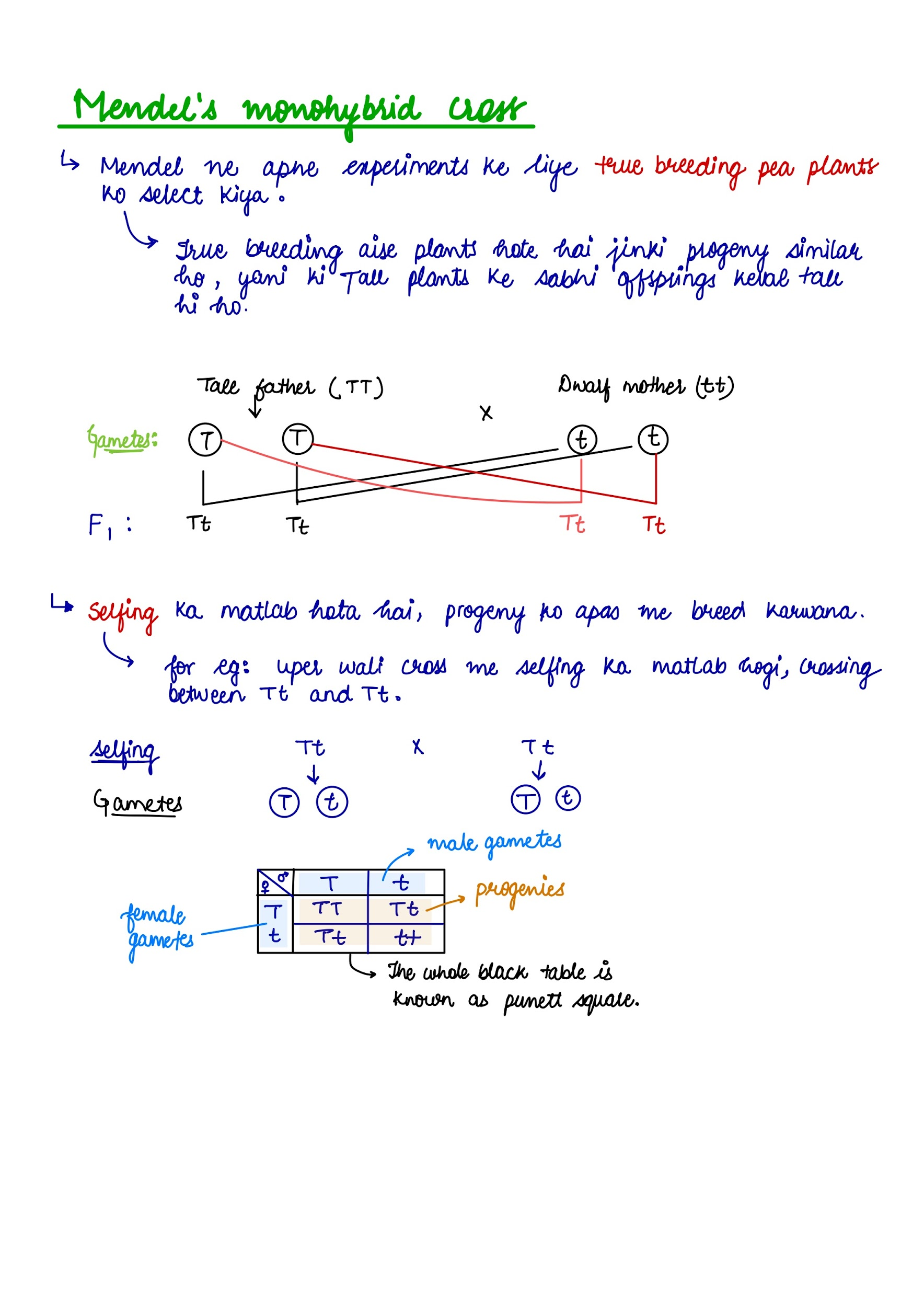

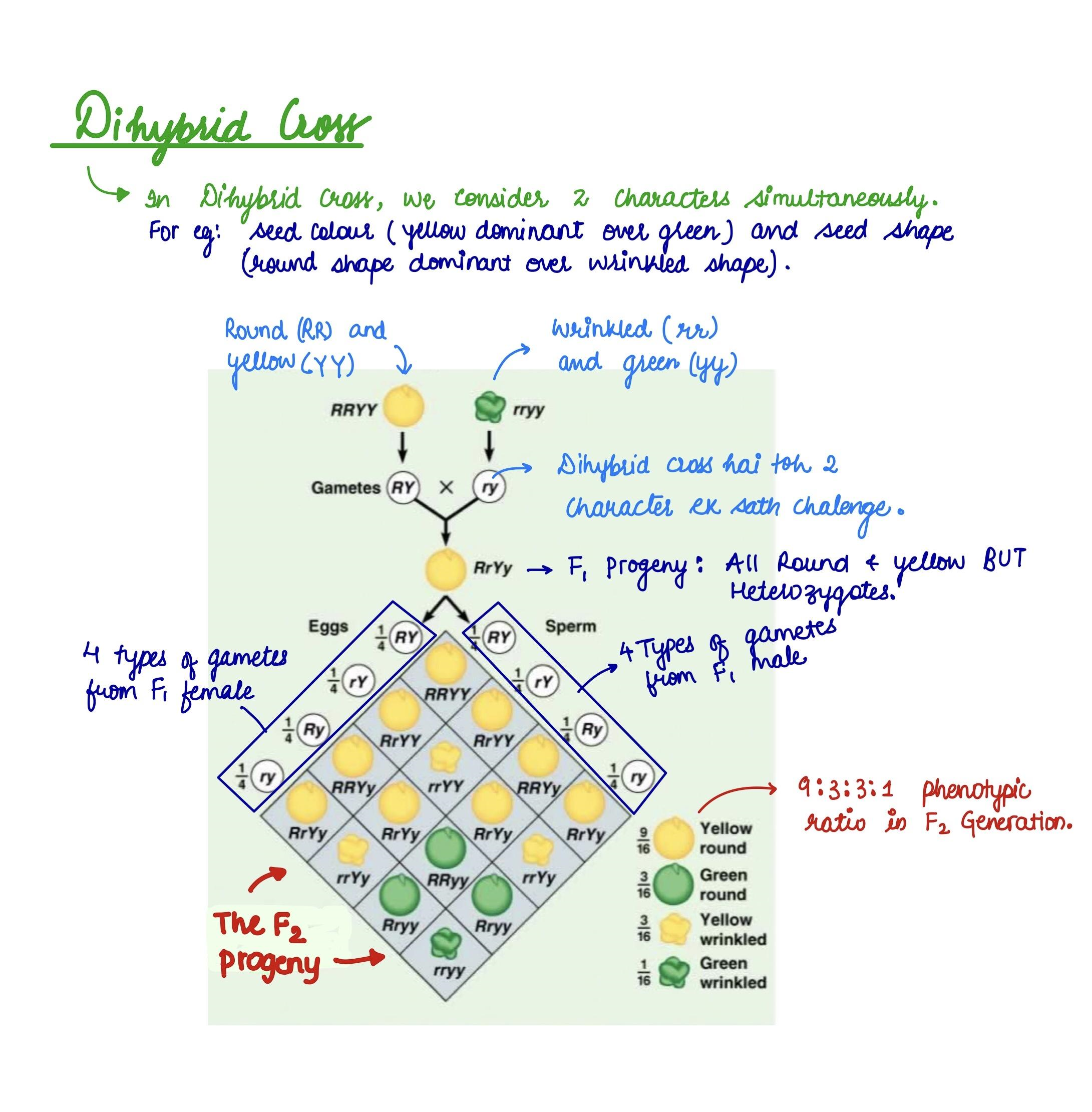
ONE MINUTE REVISION



MENDEL’S DIHYBRID CROSS
- INHERITANCE OF TWO GENES
- After the inheritance of one gene, Mendel also studied the inheritance of two characters simultaneously.
→ A breeding experiment dealing with the inheritance of two pairs of contrasting characters at the same time is called a dihybrid cross. - He hybridized a pea plant having round seed and yellow cotyledon with a pea plant having wrinkled seeds and green cotyledon.
- He got all the plants in F1 with round seeds and yellow cotyledons.
- F1 plants are allowed to self-pollinate, it results in the production of a total 16 number of plants.
OUTCOME OF DIHYBRID CROSS
- Four different types of plants in F2 generation
- 9 had round seeds and yellow cotyledons.
- 3 had round seeds and green cotyledons.
- 3 had yellow cotyledons and wrinkled seeds.
- 1 had green cotyledons and wrinkled seeds.
- Among four kinds of F2 plants:
NOTE
→ Thus the phenotypic ratio of a dihybrid cross is 9:3:3:1.
→ Genotypic ratio of a dihybrid cross is 1:2:2:4:1:2:1:2:1.
→ The two with round and yellow seeds and wrinkled and green seeds had parental combinations.
→ The other two with round and green seeds and wrinkled and green seeds had new combinations.
CONCLUSIONS DRAWN FROM THE DIHYBRID CROSS
- CONCLUSION
The inheritance of seed shape was independent of the inheritance of cotyledon colour.
LAW OF INDEPENDENT ASSORTMENT
Statement
It states that when two pairs of contrasting traits are combined in a hybrid, segregation of one pair of characters is independent of the other pair of characters. These factors randomly rearrange in the offsprings producing both parental and new combinations of characters.
NOTE: Law of segregation and Independent Assortment are universally applicable, whereas other principles have some exceptions.
Explanation
It can be understood with the help of dihybrid cross given below:

EXCEPTIONS TO MENDELIAN GENETICS
- First case of incomplete dominance or blending inheritance was reported in a 4-O'clock plant, (Mirabilis jalapa) by Carl Correns (1903).
- when plants with red flowers (RR) are crossed with plants having white flowers (rr) the hybrid F1 plants (RI) bear pink flowers.
- When these F1 plants with pink flowers are self-pollinated they develop red (RR), pink (Rr) and white (rr) flowered plants in the ratio of 1:2:1 (F2 generation).
- Here the genotype ratios were exactly as we would expect in any mendelian monohybrid cross, but the phenotype ratios had changed.
- Phenotypic ratio and genotypic ratio in case of incomplete dominance are always the same (1:2:1).
- Snapdragon or dog flower (Antirrhinum majus) is another example of incomplete dominance.
- A good example is the different types of red blood cells that determine ABO blood grouping in human beings.
- ABO blood groups are controlled by the gene I.
- The plasma membrane of the red blood cells has sugar polymers that protrude from its surface and the kind of sugar is controlled by the I gene.
- The gene (I) has three alleles IA, IB and i.
- The alleles IA and IB produce a slightly different form of the sugar while allele i doesn’t produce any sugar.
- Since humans are diploid organisms, each person possesses any two of the three I gene alleles.
- IA and IB are completely dominant over i, or we can say when IA and i are present only IA expresses (because i does not produce any sugar), and when IB and i are present IB expresses.
- when IA and IB are present together on the surface of RBCs they both express their own types of sugars: this is because of co-dominance. Hence red blood cells have both A and B types of sugars.
- Since there are three different alleles: →There are six different combinations of these three alleles that are possible a total of six different genotypes of the human ABO blood types.
INCOMPLETE DOMINANCE
StatementAfter Mendel, several cases were recorded where F1 hybrids were not related to either of the parents but exhibited a blending of characters of two parents. This is called incomplete dominance or blending inheritance.
Explanation
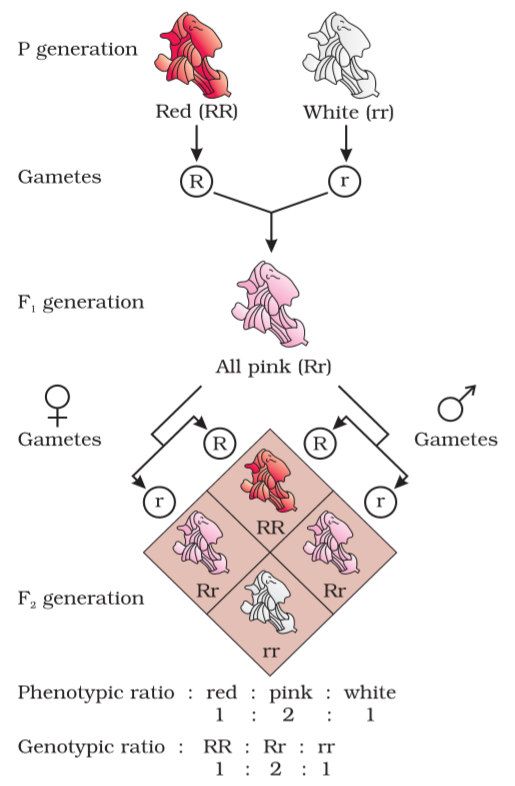
CODOMINANCE
StatementThe alleles which do not show dominance recessive relationship and are able to express themselves independently when present together are called co-dominant alleles and this phenomenon is known as codominance.
Explanation
→However possible phenotypes are only four.
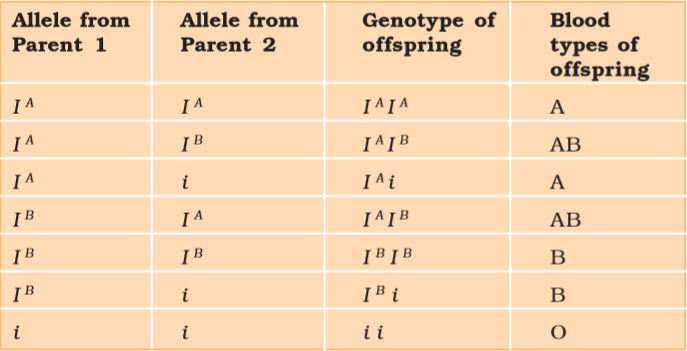

NOTE:
Incomplete Dominance and Codominance are the exceptions of law/principle of Dominance.
MULTIPLE ALLELISM
- Statement
It is a phenomenon in which a single character is governed or determined by more than two alleles.
Explanation
ABO blood grouping is an example of above-mentioned condition since in case of ABO blood grouping there are three alleles IA, IB and i which determine a single character that is blood group.PLEIOTROPY
STATEMENT
When a single gene expresses two or more than two (multiple traits) the phenomenon is known as pleiotropy.
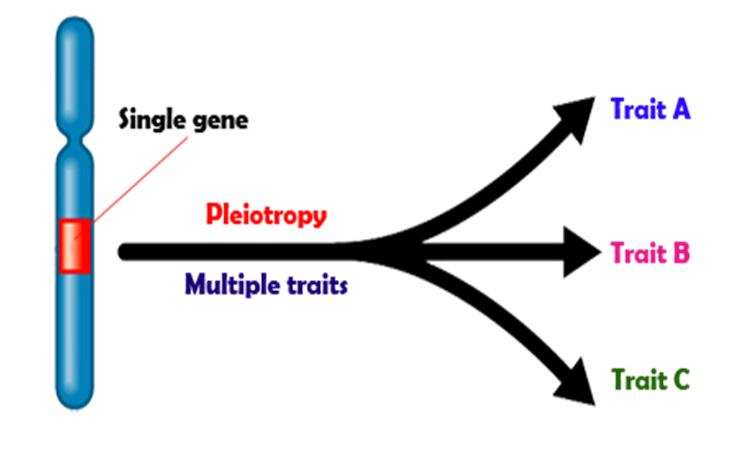
EXPLANATION
→Starch synthesis in pea seeds is controlled by one gene. It has two alleles (B and b).
→Starch is synthesised effectively by BB homozygotes and therefore, large starch grains are produced.
→In contrast, bb homozygotes have lesser efficiency in starch synthesis and produce smaller starch grains.
→Moreover the grains which have BB, Bb genotype are rounded and the one with bb genotype are wrinkled.
→Hence, here a single gene controls both, the amount of starch synthesis and shape of grain.
→Thus it is a phenomenon of pleiotropy and such genes which show pleiotropy are called pleiotropic genes..
EXCEPTIONS TO MENDELIAN GENETICS
- First case of incomplete dominance or blending inheritance was reported in a 4-O'clock plant, (Mirabilis jalapa) by Carl Correns (1903).
- when plants with red flowers (RR) are crossed with plants having white flowers (rr) the hybrid F1 plants (RI) bear pink flowers.
- When these F1 plants with pink flowers are self-pollinated they develop red (RR), pink (Rr) and white (rr) flowered plants in the ratio of 1:2:1 (F2 generation).
- Here the genotype ratios were exactly as we would expect in any mendelian monohybrid cross, but the phenotype ratios had changed.
- Phenotypic ratio and genotypic ratio in case of incomplete dominance are always the same (1:2:1).
- Snapdragon or dog flower (Antirrhinum majus) is another example of incomplete dominance.
- A good example is the different types of red blood cells that determine ABO blood grouping in human beings.
- ABO blood groups are controlled by the gene I.
- The plasma membrane of the red blood cells has sugar polymers that protrude from its surface and the kind of sugar is controlled by the I gene.
- The gene (I) has three alleles IA, IB and i.
- The alleles IA and IB produce a slightly different form of the sugar while allele i doesn’t produce any sugar.
- Since humans are diploid organisms, each person possesses any two of the three I gene alleles.
- IA and IB are completely dominant over i, or we can say when IA and i are present only IA expresses (because i does not produce any sugar), and when IB and i are present IB expresses.
- when IA and IB are present together on the surface of RBCs they both express their own types of sugars: this is because of co-dominance. Hence red blood cells have both A and B types of sugars.
- Since there are three different alleles: →There are six different combinations of these three alleles that are possible a total of six different genotypes of the human ABO blood types.
INCOMPLETE DOMINANCE
StatementAfter Mendel, several cases were recorded where F1 hybrids were not related to either of the parents but exhibited a blending of characters of two parents. This is called incomplete dominance or blending inheritance.
Explanation

CODOMINANCE
StatementThe alleles which do not show dominance recessive relationship and are able to express themselves independently when present together are called co-dominant alleles and this phenomenon is known as codominance.
Explanation
→However possible phenotypes are only four.


NOTE:
Incomplete Dominance and Codominance are the exceptions of law/principle of Dominance.
MULTIPLE ALLELISM
- Statement
It is a phenomenon in which a single character is governed or determined by more than two alleles.
Explanation
ABO blood grouping is an example of above-mentioned condition since in case of ABO blood grouping there are three alleles IA, IB and i which determine a single character that is blood group.PLEIOTROPY
STATEMENT
When a single gene expresses two or more than two (multiple traits) the phenomenon is known as pleiotropy.

EXPLANATION
→Starch synthesis in pea seeds is controlled by one gene. It has two alleles (B and b).
→Starch is synthesised effectively by BB homozygotes and therefore, large starch grains are produced.
→In contrast, bb homozygotes have lesser efficiency in starch synthesis and produce smaller starch grains.
→Moreover the grains which have BB, Bb genotype are rounded and the one with bb genotype are wrinkled.
→Hence, here a single gene controls both, the amount of starch synthesis and shape of grain.
→Thus it is a phenomenon of pleiotropy and such genes which show pleiotropy are called pleiotropic genes..
ONE MINUTE REVISION



CHROMOSOMAL THEORY OF INHERITANCE AND LINKAGE & RECOMBINATION
- Chromosome theory of inheritance was first proposed by W.S. Sutton & Boveri in 1902.
- This theory states that chromosomes are vehicles of hereditary information & expression as genes are present over them.
- Salient features of this theory are: →Gametes serve as the bridge between two successive generations.
- Chromosomes are also transferred from one generation to the next as in the case of genes (Mendelian factors).
- The number of chromosomes is fixed in each living species. These are found as homologous pairs in diploid cells. One chromosome from the father and the other contributed by the mother constitute a homologous pair.
- Before cell division, each chromosome as a whole and the alleles of genes get replicated and are separated during mitotic division.
- Meiosis takes place during gamete formation. Homologous chromosomes form synapsis during the prophase-I stage which in the later course gets separated and transferred to daughter cells.
- Each gamete or a haploid cell has only one allele of each gene present in the chromosome.
- A characteristic diploid number is again established by the union of the two haploid gametes.
- Both chromosomes and the alleles (Mendelian factors) behave in accordance with Mendel’s law of segregation.
- Linkage was was first seen by Bateson and Punnett in Lathyrus odoratus, it is an exception to the Law of Independent Assortment.
- Linkage is the phenomenon of certain genes staying together during inheritance through generations without any change or separation. →This is due to their location on the same chromosomes.
- Recombination is the rearrangement of genetic material. The generation of non-parental gene combinations during the dihybrid cross is called recombination.
- Morgan was first to carry out several dihybrid crosses in Drosophila to study genes that were sex-linked.
- Morgan hybridized yellow-bodied, white-eyed females to brown-bodied, red-eyed males and finally intercrossed F1.
- Unlinked genes (i.e., the genes found on different chromosomes) show independent assortment, a dihybrid ratio of 9:3:3:1 and the two-point test cross-ratio of 1:1:1:1 with two parental and two recombinant types. →The linked genes do not show independent assortment and show dihybrid ratio of 3: 1 and a test cross-ratio of 1: 1.
- Morgan and his group also found that even when genes were grouped on the same chromosome: →some genes were very tightly linked (showed very low recombination).
- For example, he found that the genes white and yellow were very tightly linked and showed only 1.3 percent recombination while white and miniature wing showed 37.2 percent recombination.
- His student Alfred Sturtevant used the frequency of recombination between gene pairs on the same chromosome as a measure of the distance between genes and ‘mapped’ their position on the chromosome (Genetic Map).
→Male and female gametes play an equal role in contributing hereditary components of the future generation.
.→Only the nucleus of sperm combines with the ovum. Thus, the hereditary information is contained in the nucleus.
.→Chromatin in the nucleus is associated with the cell division in the form of chromosomes.
→Any type of deletion or addition in the chromosomes can cause structural and functional changes in living beings.
→A sort of parallelism is observed between Mendelian factors and chromosomes.
→A number of genes or Mendelian factors are found in each chromosome.
→Determination of sex in most of the animals and plants is affected by specific chromosomes. These chromosomes are called sex chromosomes.
PARALLELISM BETWEEN GENE AND CHROMOSOMES
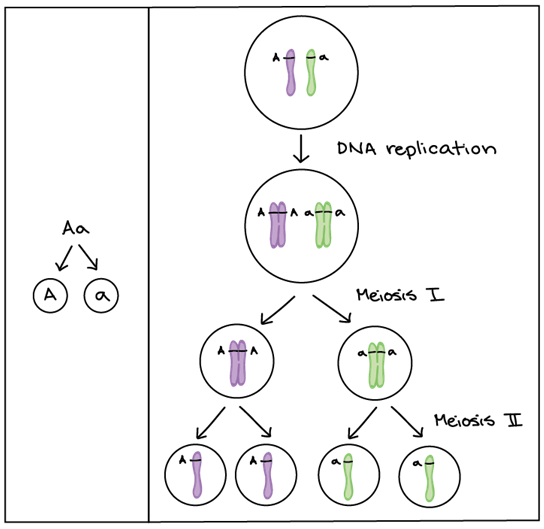
LINKAGE & RECOMBINATION
NOTE
Why morgan selected drosophila for linkage experiment ?
→They could be easily grown on simple synthetic medium in the laboratory.
→Life is short that is of two weeks, and a single mating could produce numerous eggs/progeny flies.
→There was a clear differentiation of the sexes – the male and female flies are easily distinguishable.
→It has many types of hereditary variations that can be seen with low power microscopes.
→While others were loosely linked (showed higher recombination).
NOTE :
Genetic Map
A genetic map is a type of chromosome map that shows the relative locations of genes and other important features.
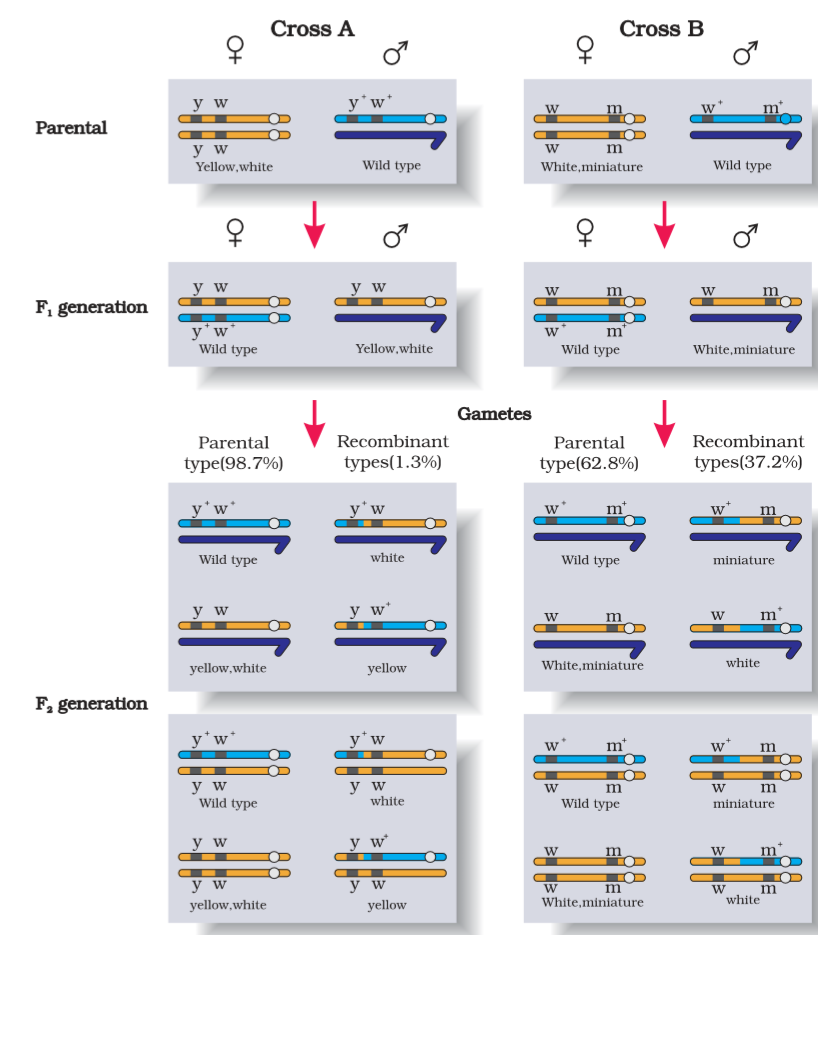
CHROMOSOMAL THEORY OF INHERITANCE AND LINKAGE & RECOMBINATION
- Chromosome theory of inheritance was first proposed by W.S. Sutton & Boveri in 1902.
- This theory states that chromosomes are vehicles of hereditary information & expression as genes are present over them.
- Salient features of this theory are: →Gametes serve as the bridge between two successive generations.
- Chromosomes are also transferred from one generation to the next as in the case of genes (Mendelian factors).
- The number of chromosomes is fixed in each living species. These are found as homologous pairs in diploid cells. One chromosome from the father and the other contributed by the mother constitute a homologous pair.
- Before cell division, each chromosome as a whole and the alleles of genes get replicated and are separated during mitotic division.
- Meiosis takes place during gamete formation. Homologous chromosomes form synapsis during the prophase-I stage which in the later course gets separated and transferred to daughter cells.
- Each gamete or a haploid cell has only one allele of each gene present in the chromosome.
- A characteristic diploid number is again established by the union of the two haploid gametes.
- Both chromosomes and the alleles (Mendelian factors) behave in accordance with Mendel’s law of segregation.
- Linkage was was first seen by Bateson and Punnett in Lathyrus odoratus, it is an exception to the Law of Independent Assortment.
- Linkage is the phenomenon of certain genes staying together during inheritance through generations without any change or separation. →This is due to their location on the same chromosomes.
- Recombination is the rearrangement of genetic material. The generation of non-parental gene combinations during the dihybrid cross is called recombination.
- Morgan was first to carry out several dihybrid crosses in Drosophila to study genes that were sex-linked.
- Morgan hybridized yellow-bodied, white-eyed females to brown-bodied, red-eyed males and finally intercrossed F1.
- Unlinked genes (i.e., the genes found on different chromosomes) show independent assortment, a dihybrid ratio of 9:3:3:1 and the two-point test cross-ratio of 1:1:1:1 with two parental and two recombinant types. →The linked genes do not show independent assortment and show dihybrid ratio of 3: 1 and a test cross-ratio of 1: 1.
- Morgan and his group also found that even when genes were grouped on the same chromosome: →some genes were very tightly linked (showed very low recombination).
- For example, he found that the genes white and yellow were very tightly linked and showed only 1.3 percent recombination while white and miniature wing showed 37.2 percent recombination.
- His student Alfred Sturtevant used the frequency of recombination between gene pairs on the same chromosome as a measure of the distance between genes and ‘mapped’ their position on the chromosome (Genetic Map).
→Male and female gametes play an equal role in contributing hereditary components of the future generation.
.→Only the nucleus of sperm combines with the ovum. Thus, the hereditary information is contained in the nucleus.
.→Chromatin in the nucleus is associated with the cell division in the form of chromosomes.
→Any type of deletion or addition in the chromosomes can cause structural and functional changes in living beings.
→A sort of parallelism is observed between Mendelian factors and chromosomes.
→A number of genes or Mendelian factors are found in each chromosome.
→Determination of sex in most of the animals and plants is affected by specific chromosomes. These chromosomes are called sex chromosomes.
PARALLELISM BETWEEN GENE AND CHROMOSOMES

LINKAGE & RECOMBINATION
NOTE
Why morgan selected drosophila for linkage experiment ?
→They could be easily grown on simple synthetic medium in the laboratory.
→Life is short that is of two weeks, and a single mating could produce numerous eggs/progeny flies.
→There was a clear differentiation of the sexes – the male and female flies are easily distinguishable.
→It has many types of hereditary variations that can be seen with low power microscopes.
→While others were loosely linked (showed higher recombination).
NOTE :
Genetic Map
A genetic map is a type of chromosome map that shows the relative locations of genes and other important features.

DEVIATIONS FROM MENDELIAN GENETICS
- INCOMPLETE DOMINANCE
- Jaisey naam hi hi bata rha hai isme ki jo dominant gene hota hai wo heterozygous condition me 100% dominant nahi hota jissey na toh pura dominant gene ka expression aata hai or na hi puri tarah recessive gene ka expression ho pata hai to we get an intermediate situation jisme expression aisey dikhta hai mano dono dominant and recessive gene ke expression blend ho kar ek nya intermediate roop dikhta hai.
- Snapdragon ke case me flower colour red (RR) is dominant over white (rr) flower colour. Toh Mendel ke according Rr genotype ka colour red hona chahiye tha but originally Rr ka colour pink hota hai kyunki R is not totally dominant over r toh R red colour ke liye responsible hai lekin sath ki sath r bhi apna white colour ka effect show karega. Toh iss case me F1 ki phenotypic ratio 1:2:1 hoti hai instead of mendelian ratio of 3:1.
- Yaha bhi naam hi bata rha hai ki dominant and recessive gene dono hi 50-50 contribute karte hain phenotype me. Jaise ki blood group ke case me. 3 allele ia, ib, io blood group ko influence karte hain. Agar kisi ka genotype iaia hai toh uska blood group A hoga, agar kisi ka genotype iaib hai toh uska blood group ab hoga. Yani ki iss case me ia and ib dono ne 50-50 contribute kiya. iaio ke case me blood group AO hoga joki a hi hota hai kyunki ia me koi expression hi nahi hota. Lekin jab ioio genotype ho toh blood group O hoga.
- Multiple ka matlab hota hai many ya ek se jyada and allelism ka matlab hai simple allele. Ek aisi condition jisme ek character 2 se jyada allele se affect / govern hota ho wo condition multiple allelism kehlati hai. Jaisey ki abhi ABO blood group ke example me dekha ki blood group ke liye we had 3 alleles, similarly skin colour ke liye 3 alleles hain : ABC, AABBCC me sabse dark skin colour hota hai and aabbcc me sabse light skin colour (albinism).
CODOMINANCE
MULTIPLE ALLELISM
SEX DETERMINATION
- Fixing the sex of an individual as it begins life is called sex determination.
- The X-chromosome was first observed by a German biologist, Henking in 1891 during the spermatogenesis in male bug and was described as X-body.
- The chromosome theory of sex determination was worked out by E.B. Wilson and Stevens (1902-1905).
→They named the X and Y chromosomes as sex-chromosomes or allosomes as they were involved in the determination of sex and other chromosomes of the cell as autosomes. - X-chromosomes carry female determining genes and Y-chromosomes have male determining genes.
- Autosomes carry genes for the somatic characters. They do not have any relation to sex.
- XX-XO TYPE
- Observed in a large number of insects.
- Here eggs bear an extra X-chromosome besides the other chromosomes (autosomes).
- On the other hand, some of the sperms bear the X-chromosome whereas some do not.
- Eggs fertilized by sperm having an X-chromosome become females and those fertilized by sperms that do not have an X-chromosome become males.
- Example: Squash bug (Anasa),Grasshopper
>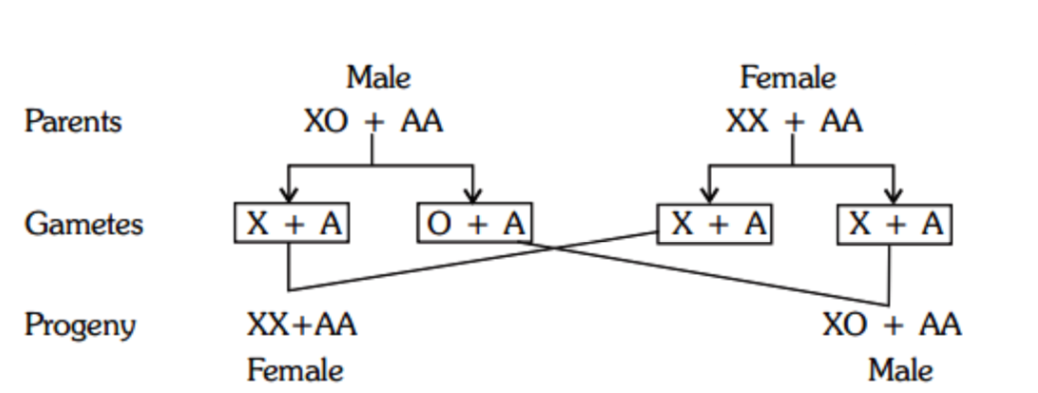
.
- XX-XY TYPE
- Observed in other insects and mammals including man.
- In case of XY type of sex determination both males and females have the same number of chromosomes.
- Males have autosomes plus X and Y chromosomes. Therefore 50% of sperms will contain an X chromosome and 50% will have a Y chromosome.
- Females have autosomes plus a pair of X chromosomes. Therefore gamete i.e ova will contain only X chromosome.
- Eggs fertilized by sperm containing X chromosome become females and those fertilized by sperms that have Y chromosome become males.
- Example: Humans and Drosophila.
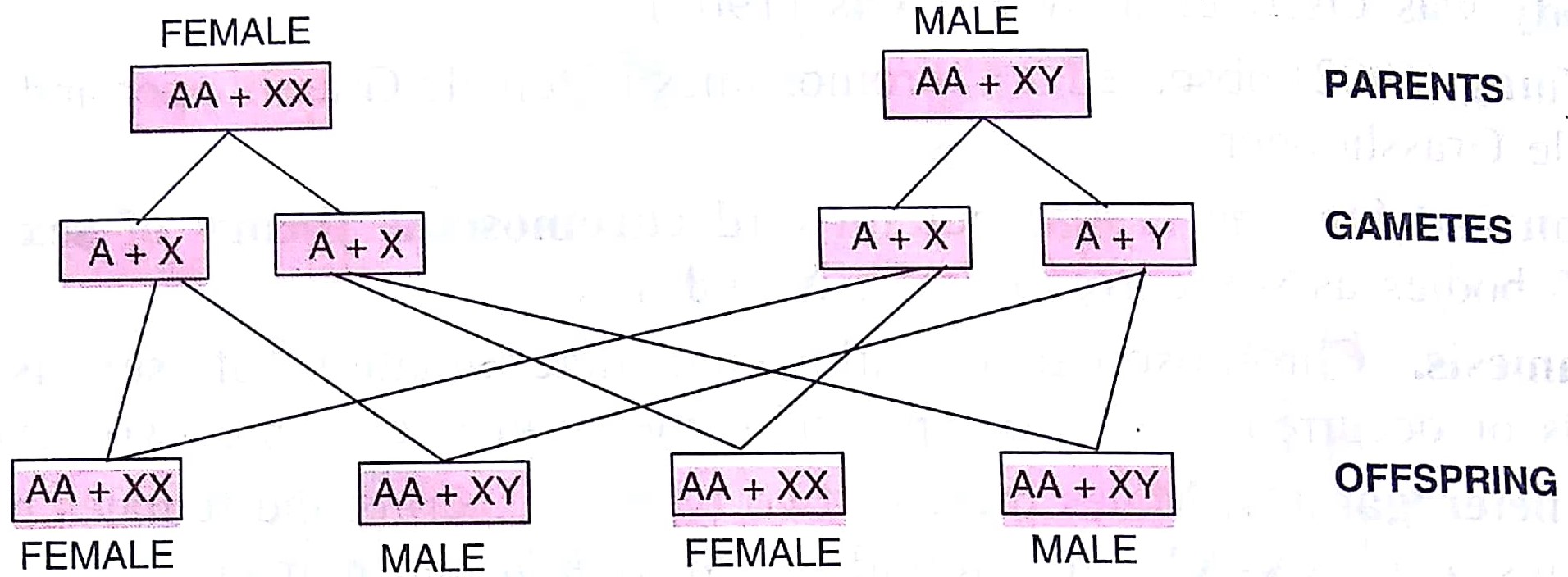
In the above description, we have studied about two types of sex-determining mechanisms, i.e., XO type and XY type. But in both cases, males produce two different types of gametes:
(a) either with or without X-chromosome.
(b) some gametes with X-chromosome and some with Y-chromosome.
Such types of sex determination mechanisms are designated to be the example of male heterogamety. - ZW-ZZ TYPE
- Observed in certain insects and vertebrates (Fishes reptiles and birds).
- In this type male has two pair of sex chromosome (ZZ). Therefore only one type of sperm is produced containing Z chromosome.
- Female, on the other hand, have ZW sex chromosomes and produce two types of gametes half with Z and other half with W chromosome.
- Fertilisation of sperm and egg containing Z and W chromosome respectively results in the formation of males whereas females are produced when both gametes containing Z chromosome fuse.
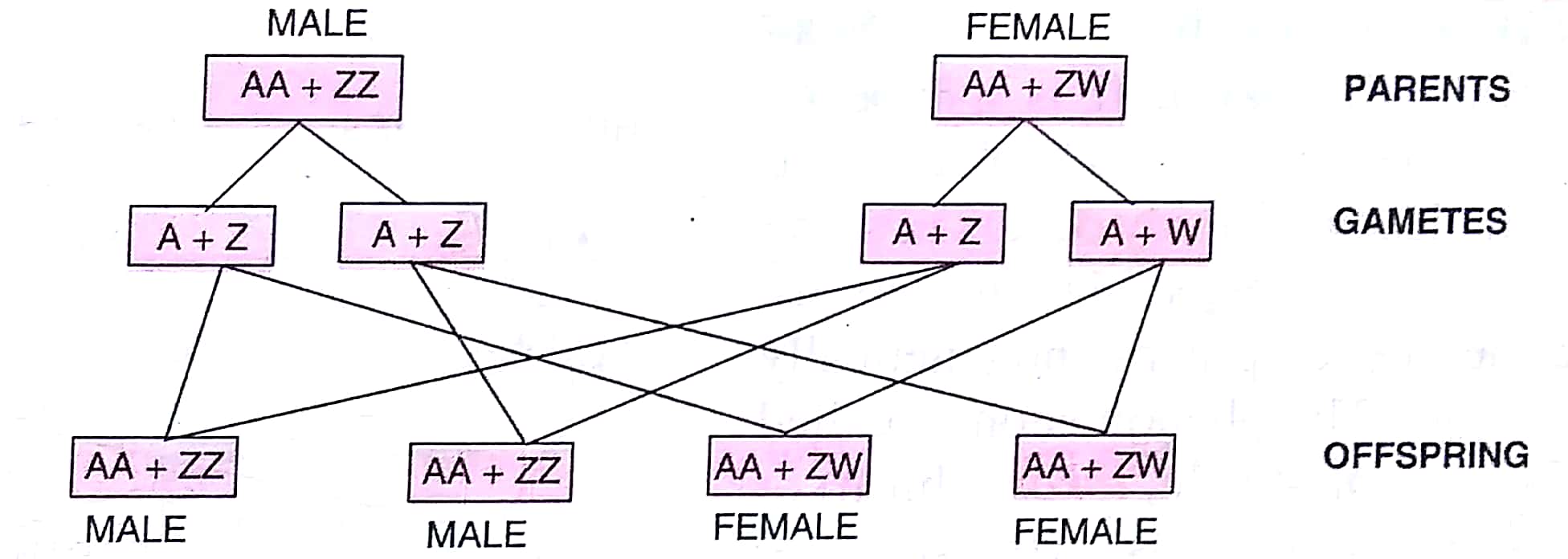
- ZO-ZZ TYPE
- Observed in certain butterflies and moths.
- Females produce two types of eggs i.e. half with Z chromosome and a half without the Z chromosome.
- Males produce only one type of sperm containing the Z chromosome.
- Fusion of sperm with Z chromosome and egg without Z chromosome result in the formation of zygotes which develop in females.
- Fusion of gametes containing Z chromosome results in the formation of male offspring.
- in both cases, females produce two different types of gametes.
(a) some gametes with Z-chromosome and some with W-chromosome.
(b) either with or without a Z-chromosome. - Such types of sex determination mechanism are designated to be the example of female heterogamety.
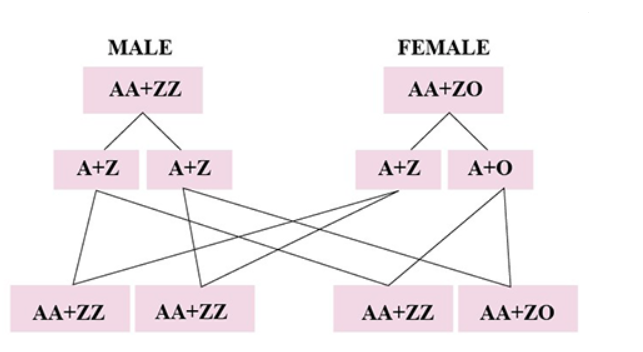
In the above two types, we have studied about two types of sex-determining mechanisms, i.e., ZW type and ZO type.
NOTE
→In case of XX-XO and XX-XY type, the male is responsible for sex determination.
→In case of ZW-ZZ and ZO-ZZ type, the female is responsible for sex determination.
CHROMOSOMAL THEORY OF SEX DETERMINATION
DIFFERENT MECHANISM OF SEX DETERMINATION
SEX DETERMINATION IN HUMANS
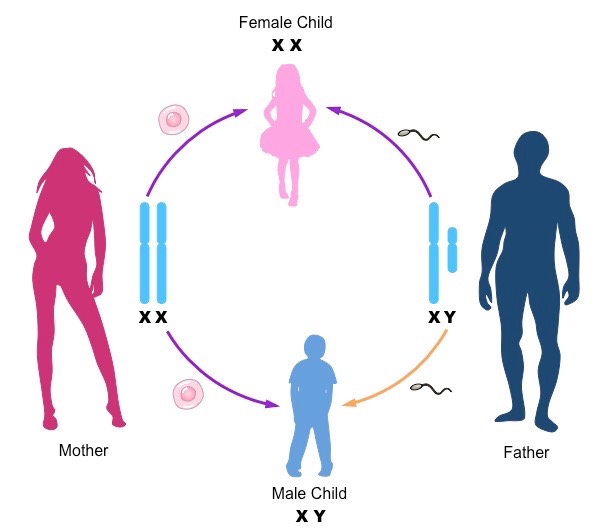
SEX DETERMINATION IN HONEY BEE
→Unfertilized egg develops into male (drone) by parthenogenesis.
- Queen (Diploid)
→Developed from unfertilized egg.
→Functional female. - Worker (Diploid)
→Developed from fertilized egg.
→Non-functional female. - Drone (Haploid)
→Developed from unfertilized egg parthenogenetically.
→Functional male.
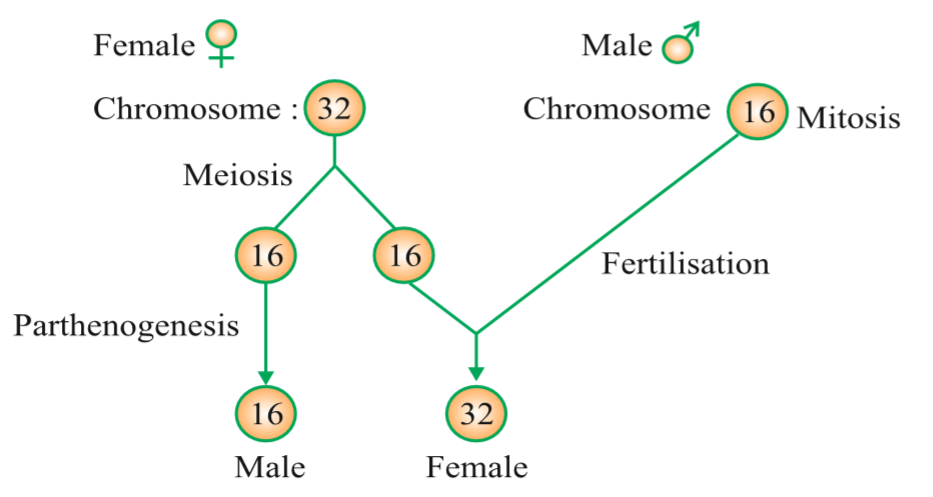
SEX DETERMINATION
- Fixing the sex of an individual as it begins life is called sex determination.
- The X-chromosome was first observed by a German biologist, Henking in 1891 during the spermatogenesis in male bug and was described as X-body.
- The chromosome theory of sex determination was worked out by E.B. Wilson and Stevens (1902-1905).
→They named the X and Y chromosomes as sex-chromosomes or allosomes as they were involved in the determination of sex and other chromosomes of the cell as autosomes. - X-chromosomes carry female determining genes and Y-chromosomes have male determining genes.
- Autosomes carry genes for the somatic characters. They do not have any relation to sex.
- XX-XO TYPE
- Observed in a large number of insects.
- Here eggs bear an extra X-chromosome besides the other chromosomes (autosomes).
- On the other hand, some of the sperms bear the X-chromosome whereas some do not.
- Eggs fertilized by sperm having an X-chromosome become females and those fertilized by sperms that do not have an X-chromosome become males.
- Example: Squash bug (Anasa),Grasshopper
>
.
- XX-XY TYPE
- Observed in other insects and mammals including man.
- In case of XY type of sex determination both males and females have the same number of chromosomes.
- Males have autosomes plus X and Y chromosomes. Therefore 50% of sperms will contain an X chromosome and 50% will have a Y chromosome.
- Females have autosomes plus a pair of X chromosomes. Therefore gamete i.e ova will contain only X chromosome.
- Eggs fertilized by sperm containing X chromosome become females and those fertilized by sperms that have Y chromosome become males.
- Example: Humans and Drosophila.

In the above description, we have studied about two types of sex-determining mechanisms, i.e., XO type and XY type. But in both cases, males produce two different types of gametes:
(a) either with or without X-chromosome.
(b) some gametes with X-chromosome and some with Y-chromosome.
Such types of sex determination mechanisms are designated to be the example of male heterogamety. - ZW-ZZ TYPE
- Observed in certain insects and vertebrates (Fishes reptiles and birds).
- In this type male has two pair of sex chromosome (ZZ). Therefore only one type of sperm is produced containing Z chromosome.
- Female, on the other hand, have ZW sex chromosomes and produce two types of gametes half with Z and other half with W chromosome.
- Fertilisation of sperm and egg containing Z and W chromosome respectively results in the formation of males whereas females are produced when both gametes containing Z chromosome fuse.

- ZO-ZZ TYPE
- Observed in certain butterflies and moths.
- Females produce two types of eggs i.e. half with Z chromosome and a half without the Z chromosome.
- Males produce only one type of sperm containing the Z chromosome.
- Fusion of sperm with Z chromosome and egg without Z chromosome result in the formation of zygotes which develop in females.
- Fusion of gametes containing Z chromosome results in the formation of male offspring.
- in both cases, females produce two different types of gametes.
(a) some gametes with Z-chromosome and some with W-chromosome.
(b) either with or without a Z-chromosome. - Such types of sex determination mechanism are designated to be the example of female heterogamety.

In the above two types, we have studied about two types of sex-determining mechanisms, i.e., ZW type and ZO type.
NOTE
→In case of XX-XO and XX-XY type, the male is responsible for sex determination.
→In case of ZW-ZZ and ZO-ZZ type, the female is responsible for sex determination.
CHROMOSOMAL THEORY OF SEX DETERMINATION
DIFFERENT MECHANISM OF SEX DETERMINATION
SEX DETERMINATION IN HUMANS

SEX DETERMINATION IN HONEY BEE
→Unfertilized egg develops into male (drone) by parthenogenesis.
- Queen (Diploid)
→Developed from unfertilized egg.
→Functional female. - Worker (Diploid)
→Developed from fertilized egg.
→Non-functional female. - Drone (Haploid)
→Developed from unfertilized egg parthenogenetically.
→Functional male.

EXCEPTIONS TO MENDELIAN GENETICS
- First case of incomplete dominance or blending inheritance was reported in a 4-O'clock plant, (Mirabilis jalapa) by Carl Correns (1903).
- when plants with red flowers (RR) are crossed with plants having white flowers (rr) the hybrid F1 plants (RI) bear pink flowers.
- When these F1 plants with pink flowers are self-pollinated they develop red (RR), pink (Rr) and white (rr) flowered plants in the ratio of 1:2:1 (F2 generation).
- Here the genotype ratios were exactly as we would expect in any mendelian monohybrid cross, but the phenotype ratios had changed.
- Phenotypic ratio and genotypic ratio in case of incomplete dominance are always the same (1:2:1).
- Snapdragon or dog flower (Antirrhinum majus) is another example of incomplete dominance.
- A good example is the different types of red blood cells that determine ABO blood grouping in human beings.
- ABO blood groups are controlled by the gene I.
- The plasma membrane of the red blood cells has sugar polymers that protrude from its surface and the kind of sugar is controlled by the I gene.
- The gene (I) has three alleles IA, IB and i.
- The alleles IA and IB produce a slightly different form of the sugar while allele i doesn’t produce any sugar.
- Since humans are diploid organisms, each person possesses any two of the three I gene alleles.
- IA and IB are completely dominant over i, or we can say when IA and i are present only IA expresses (because i does not produce any sugar), and when IB and i are present IB expresses.
- when IA and IB are present together on the surface of RBCs they both express their own types of sugars: this is because of co-dominance. Hence red blood cells have both A and B types of sugars.
- Since there are three different alleles: →There are six different combinations of these three alleles that are possible a total of six different genotypes of the human ABO blood types.
INCOMPLETE DOMINANCE
StatementAfter Mendel, several cases were recorded where F1 hybrids were not related to either of the parents but exhibited a blending of characters of two parents. This is called incomplete dominance or blending inheritance.
Explanation

CODOMINANCE
StatementThe alleles which do not show dominance recessive relationship and are able to express themselves independently when present together are called co-dominant alleles and this phenomenon is known as codominance.
Explanation
→However possible phenotypes are only four.


NOTE:
Incomplete Dominance and Codominance are the exceptions of law/principle of Dominance.
MULTIPLE ALLELISM
- Statement
It is a phenomenon in which a single character is governed or determined by more than two alleles.
Explanation
ABO blood grouping is an example of above-mentioned condition since in case of ABO blood grouping there are three alleles IA, IB and i which determine a single character that is blood group.PLEIOTROPY
STATEMENT
When a single gene expresses two or more than two (multiple traits) the phenomenon is known as pleiotropy.

EXPLANATION
→Starch synthesis in pea seeds is controlled by one gene. It has two alleles (B and b).
→Starch is synthesised effectively by BB homozygotes and therefore, large starch grains are produced.
→In contrast, bb homozygotes have lesser efficiency in starch synthesis and produce smaller starch grains.
→Moreover the grains which have BB, Bb genotype are rounded and the one with bb genotype are wrinkled.
→Hence, here a single gene controls both, the amount of starch synthesis and shape of grain.
→Thus it is a phenomenon of pleiotropy and such genes which show pleiotropy are called pleiotropic genes..
ONE MINUTE REVISION
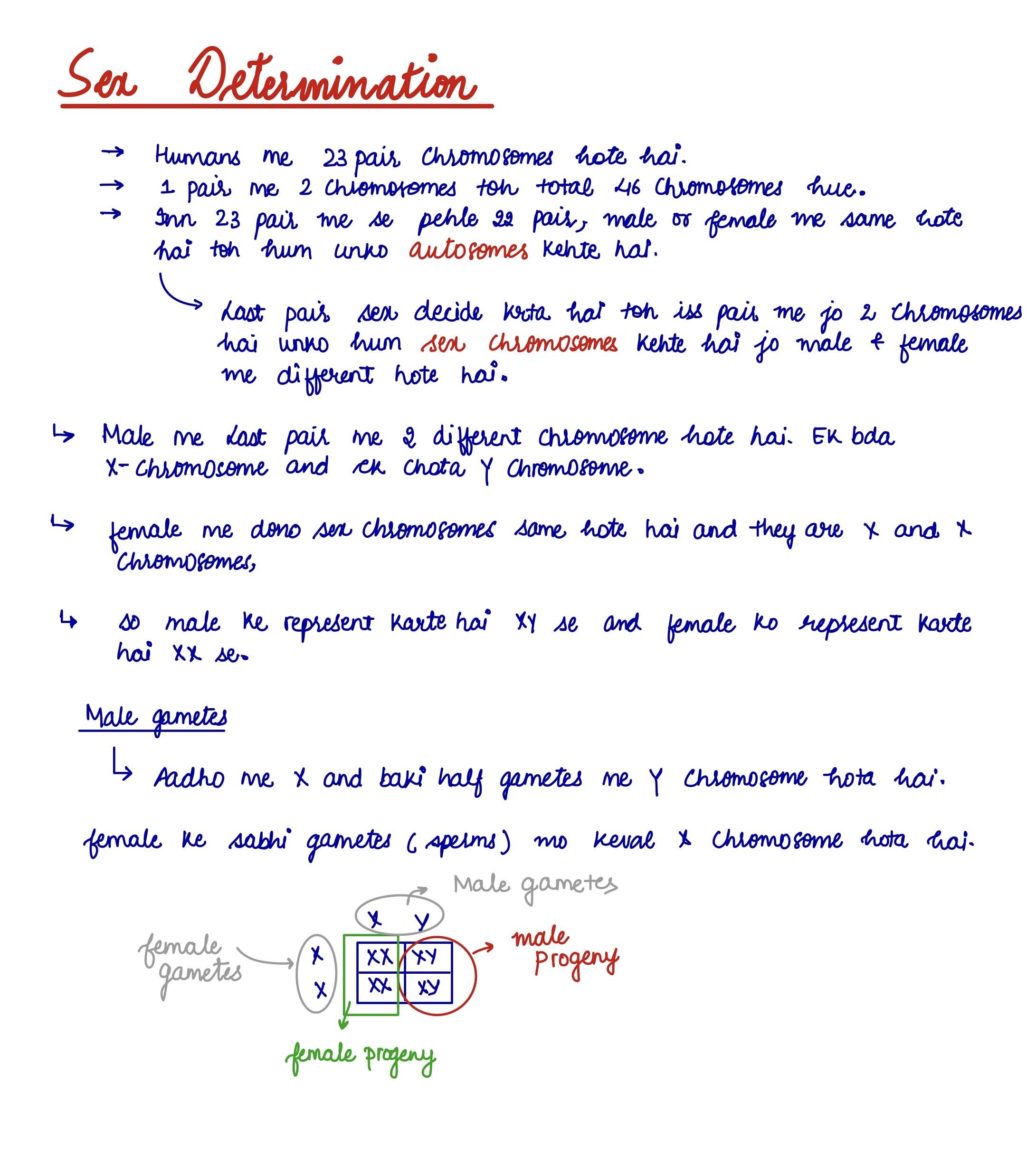
ONE MINUTE REVISION

CHROMOSOMAL THEORY OF INHERITANCE AND LINKAGE & RECOMBINATION
- Mendel ka work toh 1866 me publish ho gaya tha but nah toh logon ne accept kiya unke work ko or na hi unka work zyada logon tak pahunch paya kyunki
- Ek un dino me communication me dikkat bahut thi and printing press vgarah itni khass nahi thi.
- Dusra jin tak Mendel ka work pahucha unhone mostly usko discard kr diya kyunki tab tak kisi ne bhi biological phenomenon explain karne ke liye mathematics ko use nahi kiya tha.
- His concept of factors (now known as genes) as stable and discrete units that controlled the expression of traits and, of the pair of alleles which did not ‘blend’ with each other, was not accepted by his contemporaries as an explanation for the apparently continuous variation seen in nature.
- Toh ab ek toh Mendel ka factors ka concept logon ko samajh nahi aaya or na hi Mendel iss baat ka koi physical proof de paye ki Factors reality me exist bhi karte hain kyunki tab tak chromosome hi discover nahi hue thy.
- So Mendel ka work discard kar diya gya. 1900 tak microscope ki technique advance kar gayi thi and chromosomes ki discovery ho gyi thi toh 1900 me 3 scientists : Hugo de Vries, Correns and Von Tschermak ne independently Mendel ke work ko rediscover kiya.
- Fir uske baad 1902 me Sutton and Boveri ne paya ki meiosis ke dauran chromosomes ussi way me kaam karte hain jaisey Mendel ke factors but Mendel ne jis cheez ko factor bola tha wo chromosomes nahi balki chromosomes par located genes thy. Toh in dono ne chromosomal theory of inheritance di ki bhyii har organism me chromosomes hote hain and har organism ki puri genetic information uske chromosomes me hoti hai and yahi chromosome heritable hain jo ek progeny se next progeny ko reproduction ke time par pass on kiye jate hain. Bs yhi thi chromosomal theory of inheritance.
LINKAGE & RECOMBINATION
- Now see, ek chromosome par bahut sare genes present hote hain. Toh 2 genes ki beech me kitni physical distance hai ya koi bhi 2 genes ek dusre ke kitna pass hai, that physical association between genes is known as linkage. 2 Genes jitna ek dusre ke pass honge unme linkage utni jyada hogi and we say ki bhyii yeah gene ek dusre se linked hain kyunki gamete formation ke time inn dono ki tendency hogi ki yeah bina ek dusre se separate hue, as a single unit gamete me jayenge.
- Ab aapne 11th me meiosis padha hoga, usko recall karo ek baar ki prophase I me ek recombination ki step aati thi jahan sister chromatids ke beech me genetic material exchange hota tha (which was responsible for causing variations) and yea event recombination event kehlata hai. Toh yahan bhi hum ussi recombination ki baat karenge.
- Ab ek cheez socho, agar 2 genes apas me tightly linked hain, yanki ki unke beech me distance bahut kam hai toh jab recombination hoga toh wo dono ke dono genes ek sath jayenge iss cheez ki tendency bahut jyada badh jati hai. Vahin agar 2 genes ke beech me distance bahut jyada hoti (yani ki non linked genes) toh recombination ke time par chromosome un dono genes ke beech se tut jata and DNA ka exchange ho jata toh recombination ke baad ek gene ek arm par hota and dusra gene dusri arm par. Iss cheez ko aap neeche diye gye example ko study karke samjhna. Exams me iss par question nahi aata but genetics samajhne ke liye yeah cheez bahut jaruri hai.
MUTATION AND PEDIGREE ANALYSIS
- Any alteration in the sequence of DNA is referred to as mutation.
- These mutations get inherited from one generation to another and can change the genotype as well as the phenotype of an organism.
- Mutations are responsible for the cause of various diseases, but not all mutations are harmful since they can lead to variation.
- Changes like deletion, insertion, duplication, substitution in DNA or chromosome result in mutation. → Since genes are known to be located on chromosomes, alteration in chromosomes results in abnormalities in individuals.
- There are many mutation inducing agents (called mutagens) such as UV rays, Gamma rays, Nitrous Acid, Hydroxylamine etc.
- There are two types of genetic mutation:
- POINT MUTATION:There is a substitution in the single base pair of DNA, e.g. in the sickle cell anaemia. The 6th codon of the gene coding for the β-globin chain changes from GAG to GUG, resulting in the substitution of glutamine by Valine.
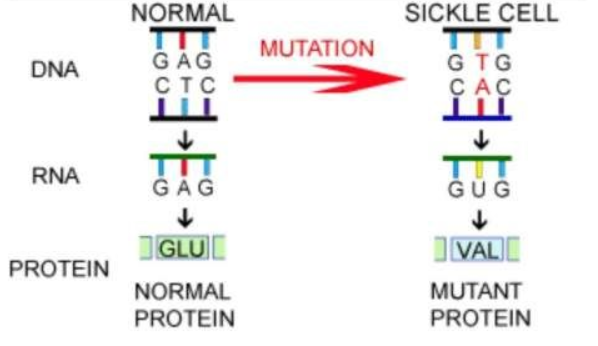
- FRAMESHIFT MUTATION : It results from the insertion or deletion of one or more pairs of bases in DNA. it changes the reading frame of triplet codons, that code for certain amino acids of the protein.

- POINT MUTATION:There is a substitution in the single base pair of DNA, e.g. in the sickle cell anaemia. The 6th codon of the gene coding for the β-globin chain changes from GAG to GUG, resulting in the substitution of glutamine by Valine.
PEDIGREE ANALYSIS
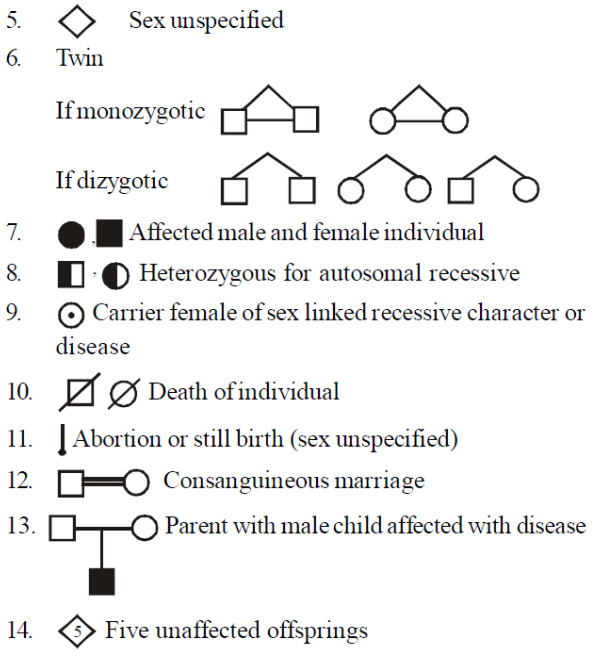
USES
- The pedigree analysis provides valuable information regarding the genetic makeup of human beings.
- If any genetic disease is occurring in a family, then pedigree analysis provides guidance to forthcoming parents about their future progenies.
MUTATION AND PEDIGREE ANALYSIS
- Any alteration in the sequence of DNA is referred to as mutation.
- These mutations get inherited from one generation to another and can change the genotype as well as the phenotype of an organism.
- Mutations are responsible for the cause of various diseases, but not all mutations are harmful since they can lead to variation.
- Changes like deletion, insertion, duplication, substitution in DNA or chromosome result in mutation. → Since genes are known to be located on chromosomes, alteration in chromosomes results in abnormalities in individuals.
- There are many mutation inducing agents (called mutagens) such as UV rays, Gamma rays, Nitrous Acid, Hydroxylamine etc.
- There are two types of genetic mutation:
- POINT MUTATION:There is a substitution in the single base pair of DNA, e.g. in the sickle cell anaemia. The 6th codon of the gene coding for the β-globin chain changes from GAG to GUG, resulting in the substitution of glutamine by Valine.

- FRAMESHIFT MUTATION : It results from the insertion or deletion of one or more pairs of bases in DNA. it changes the reading frame of triplet codons, that code for certain amino acids of the protein.

- POINT MUTATION:There is a substitution in the single base pair of DNA, e.g. in the sickle cell anaemia. The 6th codon of the gene coding for the β-globin chain changes from GAG to GUG, resulting in the substitution of glutamine by Valine.
PEDIGREE ANALYSIS

USES
- The pedigree analysis provides valuable information regarding the genetic makeup of human beings.
- If any genetic disease is occurring in a family, then pedigree analysis provides guidance to forthcoming parents about their future progenies.
CHROMOSOMAL THEORY OF INHERITANCE AND LINKAGE & RECOMBINATION
- Chromosome theory of inheritance was first proposed by W.S. Sutton & Boveri in 1902.
- This theory states that chromosomes are vehicles of hereditary information & expression as genes are present over them.
- Salient features of this theory are: →Gametes serve as the bridge between two successive generations.
- Chromosomes are also transferred from one generation to the next as in the case of genes (Mendelian factors).
- The number of chromosomes is fixed in each living species. These are found as homologous pairs in diploid cells. One chromosome from the father and the other contributed by the mother constitute a homologous pair.
- Before cell division, each chromosome as a whole and the alleles of genes get replicated and are separated during mitotic division.
- Meiosis takes place during gamete formation. Homologous chromosomes form synapsis during the prophase-I stage which in the later course gets separated and transferred to daughter cells.
- Each gamete or a haploid cell has only one allele of each gene present in the chromosome.
- A characteristic diploid number is again established by the union of the two haploid gametes.
- Both chromosomes and the alleles (Mendelian factors) behave in accordance with Mendel’s law of segregation.
- Linkage was was first seen by Bateson and Punnett in Lathyrus odoratus, it is an exception to the Law of Independent Assortment.
- Linkage is the phenomenon of certain genes staying together during inheritance through generations without any change or separation. →This is due to their location on the same chromosomes.
- Recombination is the rearrangement of genetic material. The generation of non-parental gene combinations during the dihybrid cross is called recombination.
- Morgan was first to carry out several dihybrid crosses in Drosophila to study genes that were sex-linked.
- Morgan hybridized yellow-bodied, white-eyed females to brown-bodied, red-eyed males and finally intercrossed F1.
- Unlinked genes (i.e., the genes found on different chromosomes) show independent assortment, a dihybrid ratio of 9:3:3:1 and the two-point test cross-ratio of 1:1:1:1 with two parental and two recombinant types. →The linked genes do not show independent assortment and show dihybrid ratio of 3: 1 and a test cross-ratio of 1: 1.
- Morgan and his group also found that even when genes were grouped on the same chromosome: →some genes were very tightly linked (showed very low recombination).
- For example, he found that the genes white and yellow were very tightly linked and showed only 1.3 percent recombination while white and miniature wing showed 37.2 percent recombination.
- His student Alfred Sturtevant used the frequency of recombination between gene pairs on the same chromosome as a measure of the distance between genes and ‘mapped’ their position on the chromosome (Genetic Map).
→Male and female gametes play an equal role in contributing hereditary components of the future generation.
.→Only the nucleus of sperm combines with the ovum. Thus, the hereditary information is contained in the nucleus.
.→Chromatin in the nucleus is associated with the cell division in the form of chromosomes.
→Any type of deletion or addition in the chromosomes can cause structural and functional changes in living beings.
→A sort of parallelism is observed between Mendelian factors and chromosomes.
→A number of genes or Mendelian factors are found in each chromosome.
→Determination of sex in most of the animals and plants is affected by specific chromosomes. These chromosomes are called sex chromosomes.
PARALLELISM BETWEEN GENE AND CHROMOSOMES

LINKAGE & RECOMBINATION
NOTE
Why morgan selected drosophila for linkage experiment ?
→They could be easily grown on simple synthetic medium in the laboratory.
→Life is short that is of two weeks, and a single mating could produce numerous eggs/progeny flies.
→There was a clear differentiation of the sexes – the male and female flies are easily distinguishable.
→It has many types of hereditary variations that can be seen with low power microscopes.
→While others were loosely linked (showed higher recombination).
NOTE :
Genetic Map
A genetic map is a type of chromosome map that shows the relative locations of genes and other important features.

GENETIC DISORDERS
- Disorders that arise due to abnormality in individuals’ DNA.
- Genetic disorders can be grouped into two types:
- Mendelian Disorder
- Chromosomal Disorders
MENDELIAN DISORDERS
- These are mainly determined by alternation or mutation in single genes.
- It follows the same inheritance pattern, as per Mendel’s law.
- Pedigree analysis can help trace the inheritance pattern and also determine if the trait is dominant or recessive.
- Some of mendelian disorders are mentioned below:
- HAEMOPHILIA
- Sex-linked recessive disease which is transmitted from unaffected carriers female to male progeny.
- A single protein is affected which is a part of the cascade of proteins involved in the clotting of blood.
- The heterozygous female for haemophilia may transmit the disease to her sons.
- The possibility of females suffering from this disease is extremely rare because females had two X chromosomes therefore h should be present on each X chromosome.
- This is possible only when the mother of the female is a carrier is XhX and father is haemophilic i.e. XhY too.
NOTE
Genotype and Phenotype of Individuals
XhY = affected male
XhX = carrier female
XhXh = affected female.

- HAEMOPHILIA
- SICKLE-CELL ANAEMIA
- This is an autosome linked recessive trait.
- This defect is caused by the substitution of glutamic acid (GAG) by valine (GUG) at the 6th position of the beta-globin chain of the haemoglobin molecule.
- The mutant Hb molecule undergoes polymerization under low oxygen tension which results in a change in the shape of RBC from biconcave disc to an elongated sickle-like structure.
- The disease is controlled by a pair of alleles, HbN and HbS.
NOTE
Genotype and Phenotype of Individuals
HbN HbN = Normal
HbN HbS = Carrier
HbS HbS = Affected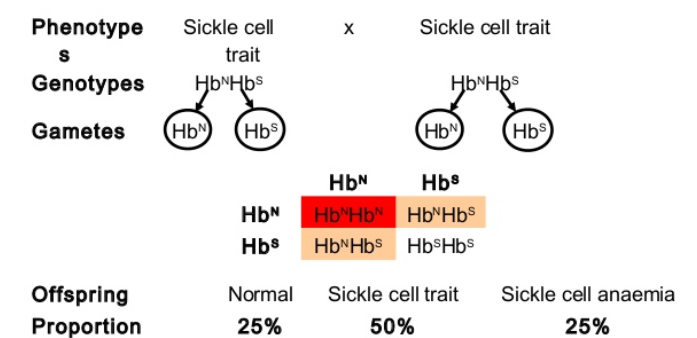
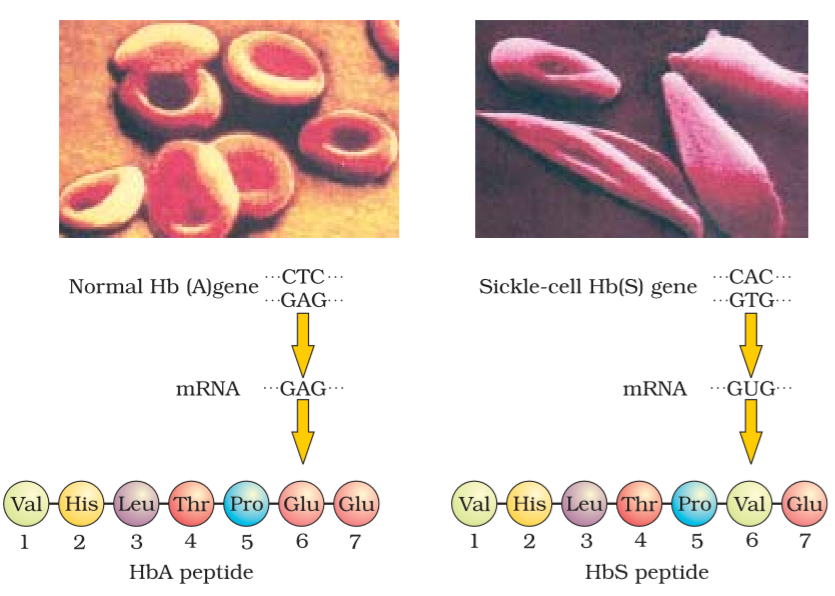
- PHENYLKETONURIA
- It is inherited as an autosomal recessive trait and is an inborn error of metabolism.
- The individual suffering from phenylketonuria lacks an enzyme that transforms amino acid phenylalanine into tyrosine.
- Therefore, phenylalanine is accumulated and converted into phenyl pyruvic acid and other derivatives.
- These derivatives accumulate in the brain and thereby result in mental retardation.
NOTE
Genotype and Phenotype of Individual
PP = Normal
Pp = Carrier
pp = Affected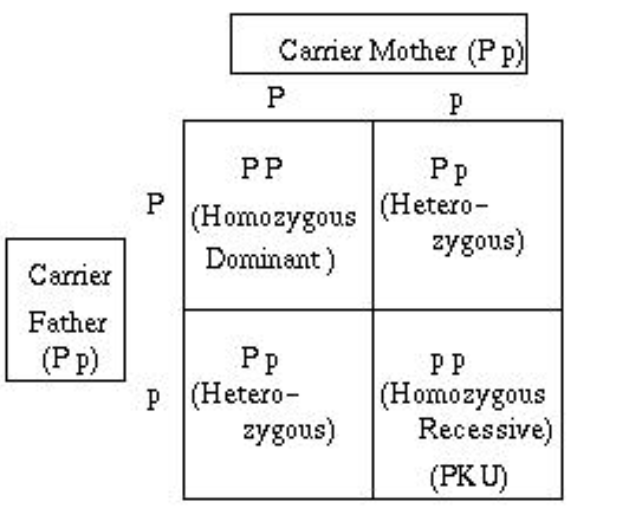
- THALASSEMIA
- Thalassemia is autosome linked recessive disease.
- This syndrome is a group of hereditary disorders of reduced haemoglobin synthesis in which there is a reduction in synthesis of one or more types of haemoglobin polypeptide chain.
- It can be of three main types:
- ALPHA THALASSEMIA
→In alpha Thalassemia production of the alpha-globin chain of haemoglobin is affected.
→This thalassemia is controlled by genes HBA1 and HBA2 located on chromosome 16th of each parent.
→Thalassemia occurs due to mutation or deletion of one or more of the four genes. - BETA THALASSEMIA
→In Beta Thalassemia production of the beta-globin chain is affected.
→This thalassemia is controlled by gene HBB located on the 11th chromosome of each parent.
→It occurs due to the deletion of one or both HBB genes. - DELTA THALASSEMIA
→It is caused due to defective allele of the HBD gene present on chromosome 2nd that forms the delta chain of haemoglobin.
→It also occurs due to deletion of one or both HBD genes.
- ALPHA THALASSEMIA
- COLOUR BLINDNESS
- Colour blindness is a sex-linked recessive trait in which a person fails to distinguish red and green colour.
- The normal and defective alleles both are present on X-chromosome.
- XN represent normal allele, XC represent colour blind allele.
- Therefore possible genotypes for male and female would be:
- Inheritance pattern of colour blindness would be:
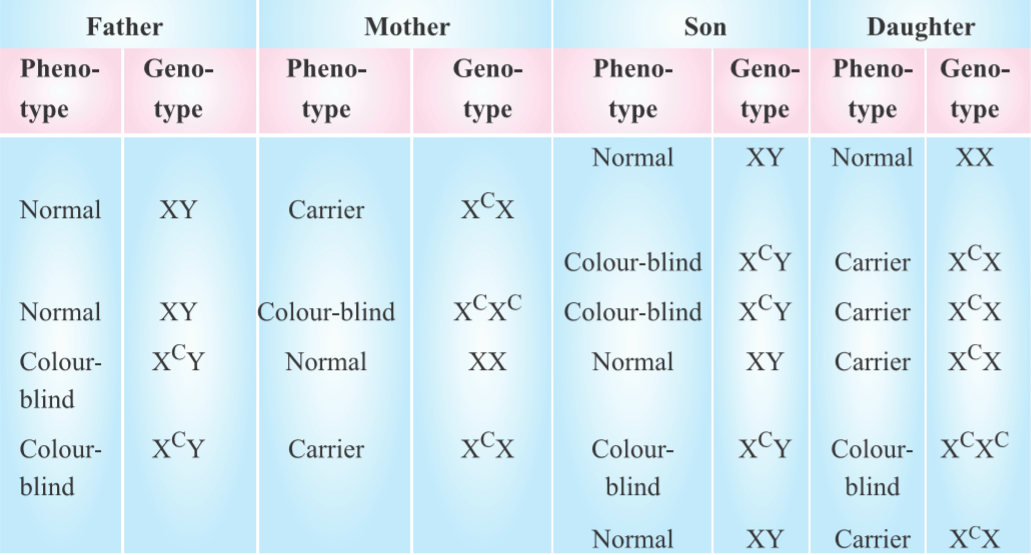
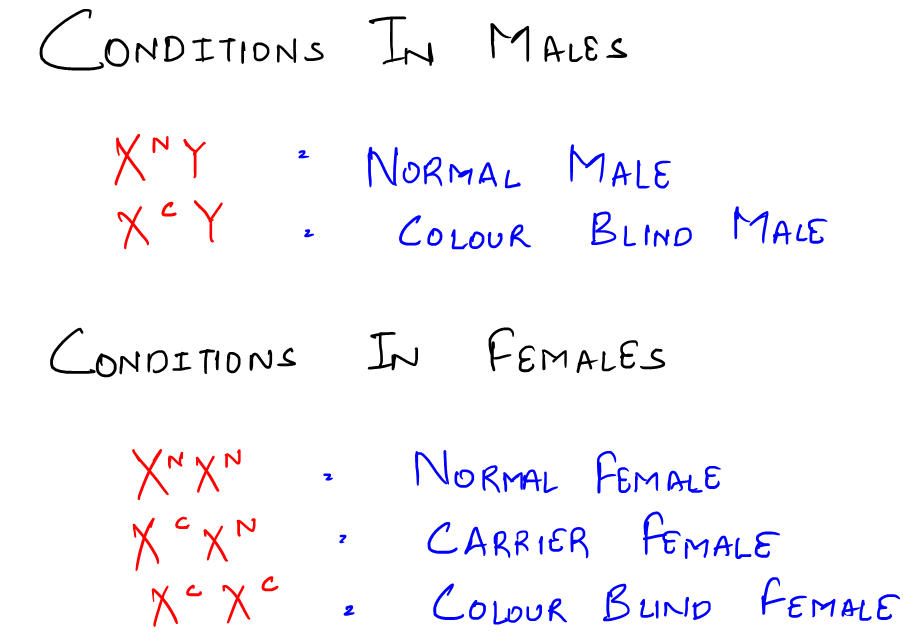
- Disorders that arise due to absence or excess or abnormal arrangement of chromosomes are known as chromosomal disorders.
- There are two phenomena that can cause this excess or absence of chromosome and result in chromosomal disorder.
- ANEUPLOIDY
→When there is failure in segregation/separation of chromatids during the cell division cycle.
→It results in gain or loss of a chromosome.
→This condition is often seen in animals. - POLYPLOIDY
→Failure of cytokinesis after telophase stage of cell division.
→It results in an increase in a whole set of chromosomes in an organism.
→This condition is often seen in plants.
- ANEUPLOIDY
- In human beings the total number of chromosomes is 46 or 23 pairs. →Of these 23 pairs, there are 22 pairs of autosomes and one pair of sex chromosomes.
- However in rare conditions an individual may have an extra copy of chromosome or may lack one of the chromosomes, these situations are known as trisomy or monosomy of a chromosome respectively.
- These conditions cause or produce disorders in humans such as Down’s syndrome, Turner’s syndrome, Klinefelter’s syndrome.
- DOWN’S SYNDROME
- Langdon Down (1866) was the first to describe this order.
- Occurs due to trisomy (2n + 1) or an additional copy of chromosome number 21.
- Affected individual: →Affected individuals are short-statured with a small round head, furrowed tongue, partially open month, broad palm.
- KLINEFELTER’S SYNDROME
- Dr. Harry Klinefelter (1942) was first to describe this disorder.
- Occurs in males due to an additional copy of X chromosome (47 chromosome) i.e XXY karyotype.
- Affected males: →Has overall masculine development with famine characters like gynaecomastia (development of breast) and is sterile.
- TURNER’S SYNDROME
- Henry Turner (1938), discovered this syndrome.
- Occurs in females due to absence of one X chromosome (45 chromosome) i.e. XO karyotype.
- Affected females: →Are sterile with rudimentary ovaries and lack secondary sexual characters.
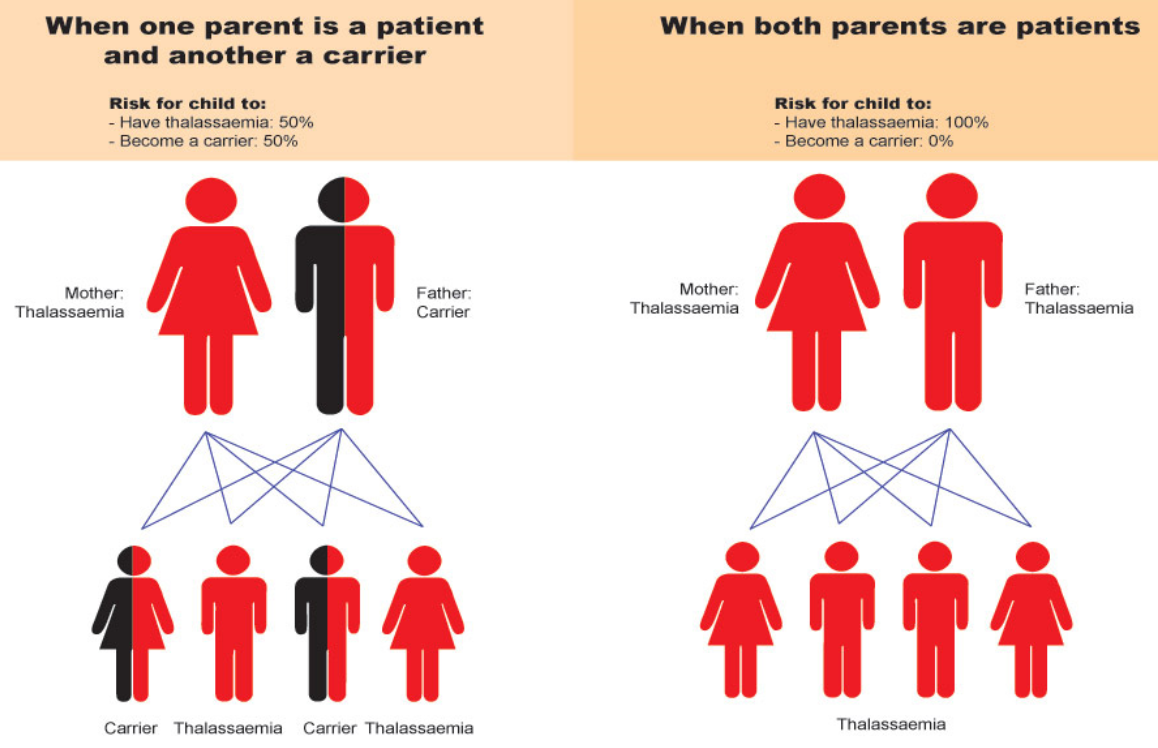

CHROMOSOMAL DISORDERS
→Physical, psychomotor and mental development is retarded.

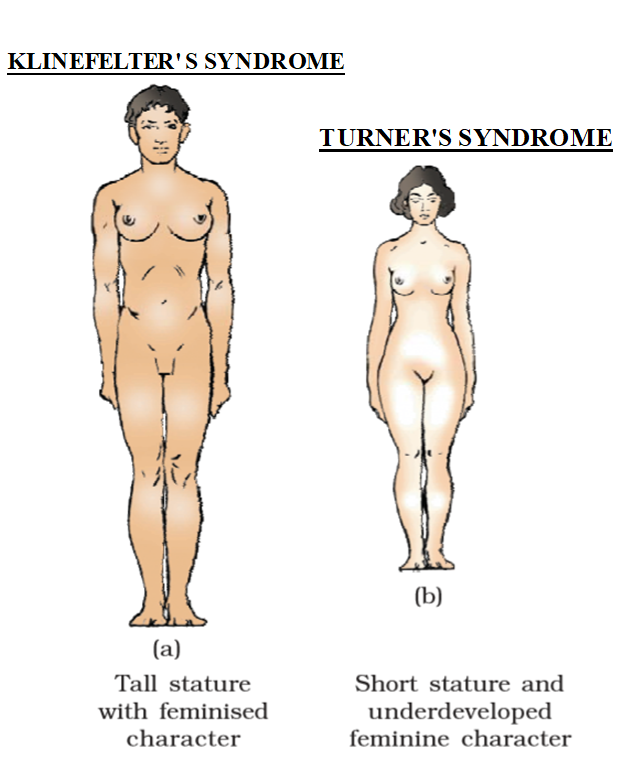
GENETIC DISORDERS
- Disorders that arise due to abnormality in individuals’ DNA.
- Genetic disorders can be grouped into two types:
- Mendelian Disorder
- Chromosomal Disorders
MENDELIAN DISORDERS
- These are mainly determined by alternation or mutation in single genes.
- It follows the same inheritance pattern, as per Mendel’s law.
- Pedigree analysis can help trace the inheritance pattern and also determine if the trait is dominant or recessive.
- Some of mendelian disorders are mentioned below:
- HAEMOPHILIA
- Sex-linked recessive disease which is transmitted from unaffected carriers female to male progeny.
- A single protein is affected which is a part of the cascade of proteins involved in the clotting of blood.
- The heterozygous female for haemophilia may transmit the disease to her sons.
- The possibility of females suffering from this disease is extremely rare because females had two X chromosomes therefore h should be present on each X chromosome.
- This is possible only when the mother of the female is a carrier is XhX and father is haemophilic i.e. XhY too.
NOTE
Genotype and Phenotype of Individuals
XhY = affected male
XhX = carrier female
XhXh = affected female.

- HAEMOPHILIA
- SICKLE-CELL ANAEMIA
- This is an autosome linked recessive trait.
- This defect is caused by the substitution of glutamic acid (GAG) by valine (GUG) at the 6th position of the beta-globin chain of the haemoglobin molecule.
- The mutant Hb molecule undergoes polymerization under low oxygen tension which results in a change in the shape of RBC from biconcave disc to an elongated sickle-like structure.
- The disease is controlled by a pair of alleles, HbN and HbS.
NOTE
Genotype and Phenotype of Individuals
HbN HbN = Normal
HbN HbS = Carrier
HbS HbS = Affected

- PHENYLKETONURIA
- It is inherited as an autosomal recessive trait and is an inborn error of metabolism.
- The individual suffering from phenylketonuria lacks an enzyme that transforms amino acid phenylalanine into tyrosine.
- Therefore, phenylalanine is accumulated and converted into phenyl pyruvic acid and other derivatives.
- These derivatives accumulate in the brain and thereby result in mental retardation.
NOTE
Genotype and Phenotype of Individual
PP = Normal
Pp = Carrier
pp = Affected
- THALASSEMIA
- Thalassemia is autosome linked recessive disease.
- This syndrome is a group of hereditary disorders of reduced haemoglobin synthesis in which there is a reduction in synthesis of one or more types of haemoglobin polypeptide chain.
- It can be of three main types:
- ALPHA THALASSEMIA
→In alpha Thalassemia production of the alpha-globin chain of haemoglobin is affected.
→This thalassemia is controlled by genes HBA1 and HBA2 located on chromosome 16th of each parent.
→Thalassemia occurs due to mutation or deletion of one or more of the four genes. - BETA THALASSEMIA
→In Beta Thalassemia production of the beta-globin chain is affected.
→This thalassemia is controlled by gene HBB located on the 11th chromosome of each parent.
→It occurs due to the deletion of one or both HBB genes. - DELTA THALASSEMIA
→It is caused due to defective allele of the HBD gene present on chromosome 2nd that forms the delta chain of haemoglobin.
→It also occurs due to deletion of one or both HBD genes.
- ALPHA THALASSEMIA
- COLOUR BLINDNESS
- Colour blindness is a sex-linked recessive trait in which a person fails to distinguish red and green colour.
- The normal and defective alleles both are present on X-chromosome.
- XN represent normal allele, XC represent colour blind allele.
- Therefore possible genotypes for male and female would be:
- Inheritance pattern of colour blindness would be:


- Disorders that arise due to absence or excess or abnormal arrangement of chromosomes are known as chromosomal disorders.
- There are two phenomena that can cause this excess or absence of chromosome and result in chromosomal disorder.
- ANEUPLOIDY
→When there is failure in segregation/separation of chromatids during the cell division cycle.
→It results in gain or loss of a chromosome.
→This condition is often seen in animals. - POLYPLOIDY
→Failure of cytokinesis after telophase stage of cell division.
→It results in an increase in a whole set of chromosomes in an organism.
→This condition is often seen in plants.
- ANEUPLOIDY
- In human beings the total number of chromosomes is 46 or 23 pairs. →Of these 23 pairs, there are 22 pairs of autosomes and one pair of sex chromosomes.
- However in rare conditions an individual may have an extra copy of chromosome or may lack one of the chromosomes, these situations are known as trisomy or monosomy of a chromosome respectively.
- These conditions cause or produce disorders in humans such as Down’s syndrome, Turner’s syndrome, Klinefelter’s syndrome.
- DOWN’S SYNDROME
- Langdon Down (1866) was the first to describe this order.
- Occurs due to trisomy (2n + 1) or an additional copy of chromosome number 21.
- Affected individual: →Affected individuals are short-statured with a small round head, furrowed tongue, partially open month, broad palm.
- KLINEFELTER’S SYNDROME
- Dr. Harry Klinefelter (1942) was first to describe this disorder.
- Occurs in males due to an additional copy of X chromosome (47 chromosome) i.e XXY karyotype.
- Affected males: →Has overall masculine development with famine characters like gynaecomastia (development of breast) and is sterile.
- TURNER’S SYNDROME
- Henry Turner (1938), discovered this syndrome.
- Occurs in females due to absence of one X chromosome (45 chromosome) i.e. XO karyotype.
- Affected females: →Are sterile with rudimentary ovaries and lack secondary sexual characters.


CHROMOSOMAL DISORDERS
→Physical, psychomotor and mental development is retarded.


SEX DETERMINATION
- Jab chromosomes discover hue toh slowly we came to know about their role. Mainly 2 type ke chromosome hote hain: autosomes and sex chromosomes. Toh sex chromosomes ek organism ka sex determine karte hain. Hum humans se shuru karte hain. Humans me female produces homogametes that is all female gametes contain a similar sex chromosome (ofcourse alongwith a set of autosomes), which is : X chromosome while human male are heterogametic. Yani ki human male ke 50% gametes me X chromosomes hota hain and baki ke 50% sperms me Y chromosome . Ab jab sperm with X chromosome, female egg ko fertilise karega toh zygote ki condition XX hogi yani ki wo zygote as a female develop karega vhi agar Y chromosome wala sperm egg ko fertilise karega toh zygote XY hoga i.e., this zygote will develop into a male. Toh yeah tha XY-XX type of sex determination.
- Now we have XX-XO type of sex determination jo hume mainly insects me dekhne ko milta hai. Iss case me female XX hoti hai toh she will produce all the gametes with X chromosomes while male is XO. Here O represents null condition. Yani ki male ke aadhe gametes me X chromosomes hoga and baki half male gametes me koi X chromosomes nahi hoga.
- Next we have ZW-ZZ type of sex determination. Iss case me female heterogametic (ZW) hoti hai and male homogametic (ZZ) hote hain. This condition is usually found in birds, reptiles, insects and some fishes.
- Next we have ZO-ZZ type case. Isme female 2 type ke gametes produce karti hai: half with Z chromosome and other half without Z chromosome. Toh yahan bhi female heterogametic hai and male keval ek type ke gametes banata hai : all with Z chromosomes. This case is usually seen in Butterflies and moths.
- Female honey bees have 32 chromosome while males have only 16 chromosomes because males develop from unfertilised egg by parthenogenesis or jo females hoti hai wo fertilised egg se develop hoti hai.
- Fertile female diploid queen lays two types of eggs : fertilised (which will develop into diploid female worker bee) and unfertilised (which will develop into haploid males).
Sex Determination In Honey Bee
ONE MINUTE REVISION

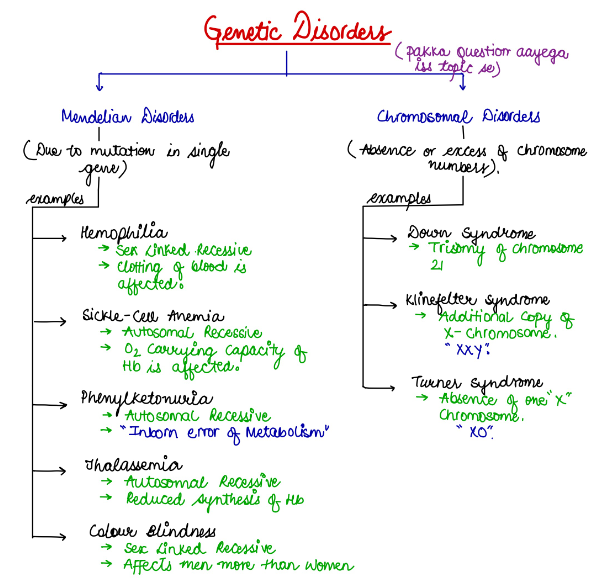
.
ONE MINUTE REVISION


.
SEX DETERMINATION
- Fixing the sex of an individual as it begins life is called sex determination.
- The X-chromosome was first observed by a German biologist, Henking in 1891 during the spermatogenesis in male bug and was described as X-body.
- The chromosome theory of sex determination was worked out by E.B. Wilson and Stevens (1902-1905).
→They named the X and Y chromosomes as sex-chromosomes or allosomes as they were involved in the determination of sex and other chromosomes of the cell as autosomes. - X-chromosomes carry female determining genes and Y-chromosomes have male determining genes.
- Autosomes carry genes for the somatic characters. They do not have any relation to sex.
- XX-XO TYPE
- Observed in a large number of insects.
- Here eggs bear an extra X-chromosome besides the other chromosomes (autosomes).
- On the other hand, some of the sperms bear the X-chromosome whereas some do not.
- Eggs fertilized by sperm having an X-chromosome become females and those fertilized by sperms that do not have an X-chromosome become males.
- Example: Squash bug (Anasa),Grasshopper
>
.
- XX-XY TYPE
- Observed in other insects and mammals including man.
- In case of XY type of sex determination both males and females have the same number of chromosomes.
- Males have autosomes plus X and Y chromosomes. Therefore 50% of sperms will contain an X chromosome and 50% will have a Y chromosome.
- Females have autosomes plus a pair of X chromosomes. Therefore gamete i.e ova will contain only X chromosome.
- Eggs fertilized by sperm containing X chromosome become females and those fertilized by sperms that have Y chromosome become males.
- Example: Humans and Drosophila.

In the above description, we have studied about two types of sex-determining mechanisms, i.e., XO type and XY type. But in both cases, males produce two different types of gametes:
(a) either with or without X-chromosome.
(b) some gametes with X-chromosome and some with Y-chromosome.
Such types of sex determination mechanisms are designated to be the example of male heterogamety. - ZW-ZZ TYPE
- Observed in certain insects and vertebrates (Fishes reptiles and birds).
- In this type male has two pair of sex chromosome (ZZ). Therefore only one type of sperm is produced containing Z chromosome.
- Female, on the other hand, have ZW sex chromosomes and produce two types of gametes half with Z and other half with W chromosome.
- Fertilisation of sperm and egg containing Z and W chromosome respectively results in the formation of males whereas females are produced when both gametes containing Z chromosome fuse.

- ZO-ZZ TYPE
- Observed in certain butterflies and moths.
- Females produce two types of eggs i.e. half with Z chromosome and a half without the Z chromosome.
- Males produce only one type of sperm containing the Z chromosome.
- Fusion of sperm with Z chromosome and egg without Z chromosome result in the formation of zygotes which develop in females.
- Fusion of gametes containing Z chromosome results in the formation of male offspring.
- in both cases, females produce two different types of gametes.
(a) some gametes with Z-chromosome and some with W-chromosome.
(b) either with or without a Z-chromosome. - Such types of sex determination mechanism are designated to be the example of female heterogamety.

In the above two types, we have studied about two types of sex-determining mechanisms, i.e., ZW type and ZO type.
NOTE
→In case of XX-XO and XX-XY type, the male is responsible for sex determination.
→In case of ZW-ZZ and ZO-ZZ type, the female is responsible for sex determination.
CHROMOSOMAL THEORY OF SEX DETERMINATION
DIFFERENT MECHANISM OF SEX DETERMINATION
SEX DETERMINATION IN HUMANS

SEX DETERMINATION IN HONEY BEE
→Unfertilized egg develops into male (drone) by parthenogenesis.
- Queen (Diploid)
→Developed from unfertilized egg.
→Functional female. - Worker (Diploid)
→Developed from fertilized egg.
→Non-functional female. - Drone (Haploid)
→Developed from unfertilized egg parthenogenetically.
→Functional male.

SUMMARY
- Genetics is a branch of biology which deals with principles of inheritance and its practices. Progeny resembling the parents in morphological and physiological features has attracted the attention of many biologists. Mendel was the first to study this phenomenon systematically. While studying the pattern of inheritance in pea plants of contrasting characters, Mendel proposed the principles of inheritance, which are today referred to as ‘Mendel’s Laws of Inheritance’. He proposed that the ‘factors’ (later named as genes) regulating the characters are found in pairs known as alleles. He observed that the expression of the characters in the offspring follows a definite pattern in different–first generations (F1), second (F2) and so on. Some characters are dominant over others. The dominant characters are expressed when factors are in heterozygous condition (Law of Dominance). The recessive characters are only expressed in homozygous conditions. The characters never blend in heterozygous condition. A recessive character that was not expressed in heterozygous condition may be expressed again when it becomes homozygous. Hence, characters segregate while the formation of gametes (Law of Segregation).
- Not all characters show true dominance. Some characters show incomplete, and some show Co-dominance. When Mendel studied the inheritance of two characters together, it was found that the factors independently assort and combine in all permutations and combinations (Law of Independent Assortment). Different combinations of gametes are theoretically represented in a square tabular form known as ‘Punnett Square’. The factors (now known as a gene) on chromosomes regulating the characters are called the genotype and the physical expression of the characters is called the phenotype.
- After knowing that the genes are located on the chromosomes, a good correlation was drawn between Mendel’s laws: segregation and assortment of chromosomes during meiosis. The Mendel’s laws were extended in the form of ‘Chromosomal Theory of Inheritance’. Later, it was found that Mendel’s law of independent assortment does not hold true for the genes that were located on the same chromosomes. These genes were called ‘linked genes’. Closely located genes assorted together, and distantly located genes, due to recombination, assorted independently. Linkage maps, therefore, correspond to the arrangement of genes on a chromosome.
- Many genes were linked to sexes also and called as sex-linked genes. The two sexes (male and female) were found to have a set of chromosomes that were common, and another set which was different. The chromosomes which were different in two sexes were named as sex chromosomes. The remaining set was named as autosomes. In humans, a normal female has 22 pairs of autosomes and a pair of sex chromosomes (XX). A male has 22 pairs of autosomes and a pair of sex chromosome as XY. In chicken, sex chromosomes in male are ZZ, and in females are ZW.
- Mutation is defined as change in the genetic material. A point mutation is a change of a single base pair in DNA. Sickle-cell anemia is caused due to change of one base in the gene coding for beta-chain of hemoglobin. Inheritable mutations can be studied by generating a pedigree of a family. Some mutations involve changes in the whole set of chromosomes (polyploidy) or change in a subset of chromosome number (aneuploidy). This helped in understanding the mutational basis of genetic disorders. Down’s syndrome is due to trisomy of chromosome 21, where there is an extra copy of chromosome 21 and consequently the total number of chromosomes becomes 47. In Turner’s syndrome, one X chromosome is missing and the sex chromosome is as XO, and in Klinefelter’s syndrome, the condition is XXY. These can be easily studied by analysis of Karyotypes.
SUMMARY
- Genetics is a branch of biology which deals with principles of inheritance and its practices. Progeny resembling the parents in morphological and physiological features has attracted the attention of many biologists. Mendel was the first to study this phenomenon systematically. While studying the pattern of inheritance in pea plants of contrasting characters, Mendel proposed the principles of inheritance, which are today referred to as ‘Mendel’s Laws of Inheritance’. He proposed that the ‘factors’ (later named as genes) regulating the characters are found in pairs known as alleles. He observed that the expression of the characters in the offspring follows a definite pattern in different–first generations (F1), second (F2) and so on. Some characters are dominant over others. The dominant characters are expressed when factors are in heterozygous condition (Law of Dominance). The recessive characters are only expressed in homozygous conditions. The characters never blend in heterozygous condition. A recessive character that was not expressed in heterozygous condition may be expressed again when it becomes homozygous. Hence, characters segregate while the formation of gametes (Law of Segregation).
- Not all characters show true dominance. Some characters show incomplete, and some show Co-dominance. When Mendel studied the inheritance of two characters together, it was found that the factors independently assort and combine in all permutations and combinations (Law of Independent Assortment). Different combinations of gametes are theoretically represented in a square tabular form known as ‘Punnett Square’. The factors (now known as a gene) on chromosomes regulating the characters are called the genotype and the physical expression of the characters is called the phenotype.
- After knowing that the genes are located on the chromosomes, a good correlation was drawn between Mendel’s laws: segregation and assortment of chromosomes during meiosis. The Mendel’s laws were extended in the form of ‘Chromosomal Theory of Inheritance’. Later, it was found that Mendel’s law of independent assortment does not hold true for the genes that were located on the same chromosomes. These genes were called ‘linked genes’. Closely located genes assorted together, and distantly located genes, due to recombination, assorted independently. Linkage maps, therefore, correspond to the arrangement of genes on a chromosome.
- Many genes were linked to sexes also and called as sex-linked genes. The two sexes (male and female) were found to have a set of chromosomes that were common, and another set which was different. The chromosomes which were different in two sexes were named as sex chromosomes. The remaining set was named as autosomes. In humans, a normal female has 22 pairs of autosomes and a pair of sex chromosomes (XX). A male has 22 pairs of autosomes and a pair of sex chromosome as XY. In chicken, sex chromosomes in male are ZZ, and in females are ZW.
- Mutation is defined as change in the genetic material. A point mutation is a change of a single base pair in DNA. Sickle-cell anemia is caused due to change of one base in the gene coding for beta-chain of hemoglobin. Inheritable mutations can be studied by generating a pedigree of a family. Some mutations involve changes in the whole set of chromosomes (polyploidy) or change in a subset of chromosome number (aneuploidy). This helped in understanding the mutational basis of genetic disorders. Down’s syndrome is due to trisomy of chromosome 21, where there is an extra copy of chromosome 21 and consequently the total number of chromosomes becomes 47. In Turner’s syndrome, one X chromosome is missing and the sex chromosome is as XO, and in Klinefelter’s syndrome, the condition is XXY. These can be easily studied by analysis of Karyotypes.
ONE MINUTE REVISION

MUTATION AND PEDIGREE ANALYSIS
- Aapke normal original DNA me ek particular sequence hoti hai. Agar uss natural sequence me koi change aajaye, DNA ka kuch part delete ho jaye ya kuch new part add ho toh that is mutation. Mutation ka matlab hota hai sudden change. Kisi bhi karan se mutation ho sakti hai jaise ki ionizing radiation (X ray and gamma rays), Uv light, nitrous acid (HNO2) and even kuch viral infections bhi mutations cause kar dete hain. Sometimes these mutation are helpful and new species ke evolution me help krti hain (we will study this concept in detail in evolution chapter). Toh iss chapter me abhi ke liye itna hi kafi hai. Baki kuch part mutation ka hum next chapter me discuss karenge kyunki vahan hum DNA ka structure padhenge ki actually me DNA kya hai and genes konsa part hota hai. Jab wo samajh aayga toh niche likhi hui frameshift mutation, nonsense mutation vgarah sab samjh aayga.
- Ab next hamare paas hai pedigree analysis. Pedigree kisi bhi family ki genetic history hoti hai and it helps to trace any genetic disease that has been running in the family. Issi cheez ki study ko hum pedigree analysis kehte hain, toh its like study of genetic tree of a family. Jaise aap logon ne movies vgarah me generally aapne family tree dekha hoga jisme a tree ki different branches pe different family members hote hain. Aise hi pedigree me hum bas male and female ke liye rectangle and circle use krte hain. Marriage ko denote karne ke liye we use a horizontal line between the male and the female. Agar kisi individual me koi genetic disease hai and wo banda ussey affected hai toh hum uss individual ki shape ko completely shade kar detey hain and agar wo keval uss disease ka carrier hai (yani ki usme disease cause karne ka gene hai but usko khud koi bimari nahi hai halanki wo bimari ko aage progeny me jarur pass kar sakta hai) toh uss individual ki shape ke centre me hum ek dot laga detey hain.
- Neeche figure me pedigree chart me use hone wali different images hain. Have a look at them. Pedigree chart ka analysis aapke CBSE ke paper me generally nahi pucha jata but ab kuch time se ispe questions kabhi kabhi puch liya ja rha hai toh do not ignore it completely. Yeah pucha jata hai generally at the level of competitive examination ki pedigree ko dekh kar yeah batao ko koi disease sex related disease hai ya autosomal related hai. Next section me hum various genetic disorders ke baare me discuss karenge and vhi possible hua toh kuch pedigree charts bhi aapko show karke yeah btayenge ki how to read a pedigree.
MUTATION AND PEDIGREE ANALYSIS
- Any alteration in the sequence of DNA is referred to as mutation.
- These mutations get inherited from one generation to another and can change the genotype as well as the phenotype of an organism.
- Mutations are responsible for the cause of various diseases, but not all mutations are harmful since they can lead to variation.
- Changes like deletion, insertion, duplication, substitution in DNA or chromosome result in mutation. → Since genes are known to be located on chromosomes, alteration in chromosomes results in abnormalities in individuals.
- There are many mutation inducing agents (called mutagens) such as UV rays, Gamma rays, Nitrous Acid, Hydroxylamine etc.
- There are two types of genetic mutation:
- POINT MUTATION:There is a substitution in the single base pair of DNA, e.g. in the sickle cell anaemia. The 6th codon of the gene coding for the β-globin chain changes from GAG to GUG, resulting in the substitution of glutamine by Valine.

- FRAMESHIFT MUTATION : It results from the insertion or deletion of one or more pairs of bases in DNA. it changes the reading frame of triplet codons, that code for certain amino acids of the protein.

- POINT MUTATION:There is a substitution in the single base pair of DNA, e.g. in the sickle cell anaemia. The 6th codon of the gene coding for the β-globin chain changes from GAG to GUG, resulting in the substitution of glutamine by Valine.
PEDIGREE ANALYSIS

USES
- The pedigree analysis provides valuable information regarding the genetic makeup of human beings.
- If any genetic disease is occurring in a family, then pedigree analysis provides guidance to forthcoming parents about their future progenies.
GENETIC DISORDERS
- Genetic disorders se matlab hai ki aapke genetic material (DNA) me koi alteration ya koi gadbad hui hai jiske karan normal functioning disrupt hui hai and koi dikkat aaie hai jisko aap treat nahi kar sakte. Yeah disorders generally 2 type ke hote hai :
- Mendelian Disorders : Yeah aisey disorders hain jo kisi ek single gene me mutation ke karan hote hain. Ab har trait ki humans me 2 copies hoti hain because we have 2 copies of each chromosome. Jaise ki 23 chromosomes mother se and 23 chromosomes father se. Toh for example maanlo ki kisi ek chromosome me ek gene me koi mutation aagya toh iski vajah se dikkat ho bhi sakti hai and nahi bhi kyunki abhi bhi hamare pass uss gene ki ek or functional normal copy dusre homologous chromosome par hai which may or maynot be sufficient. Agar keval ek autosomal gene me mutation hi bimari ka karan hoti hai and individual me hume uske symptoms dikhte hain toh we call it Autosomal Dominant (if gene is located on autosomes) and agar bimari ke symptoms keval tab manifest hote hain jab ek trait ke dono genes (each gene on a homologous chromosome) me mutation ho jaye and wo function na kare toh yeah case hota hai Autosomal Recessive disorder ka. And agar disease tab ho jab X ya Y chromosome par located genes me mutation ho toh that case is of Sex Linked Disorder
- Chromosomal Disorders : Yeah aisey disorders hote hain jo tab aate hain jab purey ke purey chromosome ke sath dikkat aati hai like koi ek pura ka pura chromosme hi delete hogya ho and normal 46 chromosomes ki jagah uss individual me 45 chromosomes ho ya fir kisi chromosome ki additional copy present ho toh normal 46 chromosomes ki jagah uss insaan me 47 ya 48 chromosomes ho jate hain.
Now, we will discuss each one at length.
MENDELIAN DISORDERS
- Hemophilia :
- Hemophilia aisi condition hai jisme aap ka blood normal tarike se clot nahi hota kyunki blood clotting factors genetically missing hai toh iss bimari me you can literally bleed to death. So its an X linked recessive disorder. X = this is how you represent X chromosome in a normal individual jisme koi genetic disorder nahi. Ab jisme X linked disease ho jaise ki haemophilia toh iss condition ko represent karne ke liye we use Xh jahan par h = haemophilia. So bimari ka first letter, X chromosome ki power ki tarah likha jata hai. Autosomal disorders ke liye we use A (for any autosome) and issi way me bimari ka pehla letter A ki power ki tarah likha jayga jo ki hum aage ke kuch examples me dekhenge.
- Now, coming back to hemophilia, yeah ek recessive disease hai yani ki kisi individual me iss bimari ke life threatening hone ke chances tabhi hai jab dono X chromosomes me clotting factor ke liye responsible genes mutated ho (males ka case halka sa alag hai jo ki neeche describe kiya hua hai). Toh we represent an affected haemophilic female as : XhXh and an affected male hemophilic as : XhY. Ab human male me ek hi X chromosome hota hai toh ussi me mutation se wo male hemophilic ho jayga jabki female me agae XhX condition hai, yani ki ek X chromosome bhi normal hai toh uss female me disease ke symptoms nahi honge. Yeah female khud healthy individual ki tarah life spend kar sakti hai (if there’s no major traumatic injury throughout life) but she will pass this disease to her son (NOT DAUGHTER) for sure.
- Sickle Cell Anemia :
- Iss disorder me RBC ki shape normal oval biconcave shape se badal kar sickle jaisi shape ki ho jati hai jo oxygen ke transport me less efficiency provide karti hai. Yeah defect tab hota hai jab haemoglobin ki beta chain ki 6th position par glutamic acid (GAG) ki jagah valine (GUG) aa jaye. Ab yeah disorder haemoglobins se related hai and disease ka naam S se shuru hota hai toh we represent the condition by HbS. Yeah recessive disorder hai toh bimari me dikkat jayada tabhi aati hai jab HbSHbS condition ho, yani ki beta globin ke liye responsible dono genes me mutation hui ho. Yeah condition zyada fatal isiliye hai kyunki iss genotype ke individual ke sabhi ke sabhi RBCs sickle cell ki shape ke jaisey hote hain toh oxygen carrying capacity bahut decrease ho jati hai Individual with genotype HbSHb (keval ek gene me mutation hai and ek gene normal hai) can live a fairly normal life kyunki isme keval ek hi gene mutated hai toh toh out of total RBCs keval 50% RBCs ki shape abnormal (sickle jaisi shape) hogi and baki ke 50% RBCs ki shape normal hoti hai.
- Phenylketonuria :
- Yeah bhi autosomal recessive disorder hai and it is known as inborn error of metabolism kyunki isme affected individual phenylalanine amino acid ko metabolise nahi kar pata toh iski vajah se body me phenylalanine accumulate hone lagta hai which could lead to severe intellectual disability, seizures, behavioral problems, and mental disorders. It may also result in a musty smell and lighter skin tone.
- Normal individual me, phenylalanine ko enzyme ‘Phenylalanine Hydroxylase' tyrosine me convert kr deta hai and body tyrosine ko aage baki pathways me use kar leti hai but phenylketonuria (PKU) se affected individuals me yeah particular enzyme nahi ban paya jiski vajah se yeh sab dikkatein hoti hai.
CHROMOSOMAL DISORDERS
- Down Syndrome :
- Iss syndrome me chromosome number 21 ki trisomy hoti hai. Yani ki normal individual mein har ek chromosome ki 2 copies hoti hai but down syndrome ke affected individual me chromosome number 21 ki 2 ki jagah 3 copies (trisomy) hoti hain. Affected individuals are short-statured with a small round head, furrowed tongue, partially open month, broad palm. Physical, psychomotor and mental development is retarded.
- Klinefelter Syndrome :
- Iss genetic disorder me males me X chromosome ki ek additional copy present hoti hai toh individual is represented as ‘XXY’ with a total of 47 chromosomes instead of 46 chromosomes. Yeah individual sterile hoga and has some female secondary sexual characteristics (because of additional copy of X chromosome) alongwith with overall masculine development. Toh iss disease se affected males show less body and facial hair, enlarged breasts (gynecomastia), less muscle mass, low testosterone so smaller testicles than normal size which may lead to smaller penis size along with little or no sperm production, but treatments like testosterone therapy might help with some symptoms if started at a particular age and assisted reproductive techniques might help them to father a child. Enlarged breast tissue could be removed via surgery. These treatment might give a chance to live a normal life for the individuals with klinefelter syndrome because the severity of the symptoms vary from male to male. Some show mild to little symptoms and some individuals may even go undetected throughout life.
- Turner's Syndrome :
- Females affected with this syndrome have only one X chromosome. Yani ki aisi females me ek X chromosome pura ka pura hi gayab hota hai toh their chromosome number is 45 represented as XO condition. Toh aisi females bhi normally sterile hoti hai with underdeveloped ovaries and little to no female secondary sexual characteristics along with delayed puberty, short stature, porous bone (osteoporosis), thyroid disorders, heart defects and abnormal menstrual cycle. But dekho most of these symptoms could be treated treated like heart defects ke liye surgery ek option hai, osteoporosis ke liye we can start vitamin D, Calcium and Zinc supplements, and hormone therapy (injections of female hormones depending upon are and severity of the condition) could help a female to mother a child or atleast have a normal life avoiding pschological distress.
This concludes the last topic of the chapter.
GENETIC DISORDERS
- Disorders that arise due to abnormality in individuals’ DNA.
- Genetic disorders can be grouped into two types:
- Mendelian Disorder
- Chromosomal Disorders
MENDELIAN DISORDERS
- These are mainly determined by alternation or mutation in single genes.
- It follows the same inheritance pattern, as per Mendel’s law.
- Pedigree analysis can help trace the inheritance pattern and also determine if the trait is dominant or recessive.
- Some of mendelian disorders are mentioned below:
- HAEMOPHILIA
- Sex-linked recessive disease which is transmitted from unaffected carriers female to male progeny.
- A single protein is affected which is a part of the cascade of proteins involved in the clotting of blood.
- The heterozygous female for haemophilia may transmit the disease to her sons.
- The possibility of females suffering from this disease is extremely rare because females had two X chromosomes therefore h should be present on each X chromosome.
- This is possible only when the mother of the female is a carrier is XhX and father is haemophilic i.e. XhY too.
NOTE
Genotype and Phenotype of Individuals
XhY = affected male
XhX = carrier female
XhXh = affected female.

- HAEMOPHILIA
- SICKLE-CELL ANAEMIA
- This is an autosome linked recessive trait.
- This defect is caused by the substitution of glutamic acid (GAG) by valine (GUG) at the 6th position of the beta-globin chain of the haemoglobin molecule.
- The mutant Hb molecule undergoes polymerization under low oxygen tension which results in a change in the shape of RBC from biconcave disc to an elongated sickle-like structure.
- The disease is controlled by a pair of alleles, HbN and HbS.
NOTE
Genotype and Phenotype of Individuals
HbN HbN = Normal
HbN HbS = Carrier
HbS HbS = Affected

- PHENYLKETONURIA
- It is inherited as an autosomal recessive trait and is an inborn error of metabolism.
- The individual suffering from phenylketonuria lacks an enzyme that transforms amino acid phenylalanine into tyrosine.
- Therefore, phenylalanine is accumulated and converted into phenyl pyruvic acid and other derivatives.
- These derivatives accumulate in the brain and thereby result in mental retardation.
NOTE
Genotype and Phenotype of Individual
PP = Normal
Pp = Carrier
pp = Affected
- THALASSEMIA
- Thalassemia is autosome linked recessive disease.
- This syndrome is a group of hereditary disorders of reduced haemoglobin synthesis in which there is a reduction in synthesis of one or more types of haemoglobin polypeptide chain.
- It can be of three main types:
- ALPHA THALASSEMIA
→In alpha Thalassemia production of the alpha-globin chain of haemoglobin is affected.
→This thalassemia is controlled by genes HBA1 and HBA2 located on chromosome 16th of each parent.
→Thalassemia occurs due to mutation or deletion of one or more of the four genes. - BETA THALASSEMIA
→In Beta Thalassemia production of the beta-globin chain is affected.
→This thalassemia is controlled by gene HBB located on the 11th chromosome of each parent.
→It occurs due to the deletion of one or both HBB genes. - DELTA THALASSEMIA
→It is caused due to defective allele of the HBD gene present on chromosome 2nd that forms the delta chain of haemoglobin.
→It also occurs due to deletion of one or both HBD genes.
- ALPHA THALASSEMIA
- COLOUR BLINDNESS
- Colour blindness is a sex-linked recessive trait in which a person fails to distinguish red and green colour.
- The normal and defective alleles both are present on X-chromosome.
- XN represent normal allele, XC represent colour blind allele.
- Therefore possible genotypes for male and female would be:
- Inheritance pattern of colour blindness would be:


- Disorders that arise due to absence or excess or abnormal arrangement of chromosomes are known as chromosomal disorders.
- There are two phenomena that can cause this excess or absence of chromosome and result in chromosomal disorder.
- ANEUPLOIDY
→When there is failure in segregation/separation of chromatids during the cell division cycle.
→It results in gain or loss of a chromosome.
→This condition is often seen in animals. - POLYPLOIDY
→Failure of cytokinesis after telophase stage of cell division.
→It results in an increase in a whole set of chromosomes in an organism.
→This condition is often seen in plants.
- ANEUPLOIDY
- In human beings the total number of chromosomes is 46 or 23 pairs. →Of these 23 pairs, there are 22 pairs of autosomes and one pair of sex chromosomes.
- However in rare conditions an individual may have an extra copy of chromosome or may lack one of the chromosomes, these situations are known as trisomy or monosomy of a chromosome respectively.
- These conditions cause or produce disorders in humans such as Down’s syndrome, Turner’s syndrome, Klinefelter’s syndrome.
- DOWN’S SYNDROME
- Langdon Down (1866) was the first to describe this order.
- Occurs due to trisomy (2n + 1) or an additional copy of chromosome number 21.
- Affected individual: →Affected individuals are short-statured with a small round head, furrowed tongue, partially open month, broad palm.
- KLINEFELTER’S SYNDROME
- Dr. Harry Klinefelter (1942) was first to describe this disorder.
- Occurs in males due to an additional copy of X chromosome (47 chromosome) i.e XXY karyotype.
- Affected males: →Has overall masculine development with famine characters like gynaecomastia (development of breast) and is sterile.
- TURNER’S SYNDROME
- Henry Turner (1938), discovered this syndrome.
- Occurs in females due to absence of one X chromosome (45 chromosome) i.e. XO karyotype.
- Affected females: →Are sterile with rudimentary ovaries and lack secondary sexual characters.


CHROMOSOMAL DISORDERS
→Physical, psychomotor and mental development is retarded.


